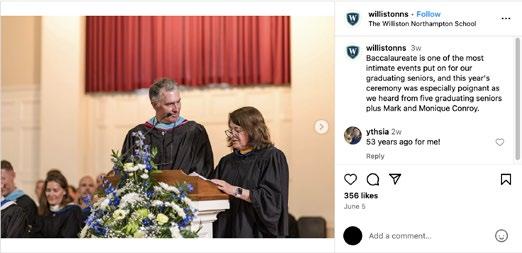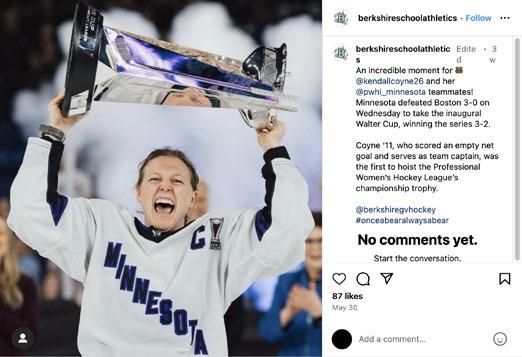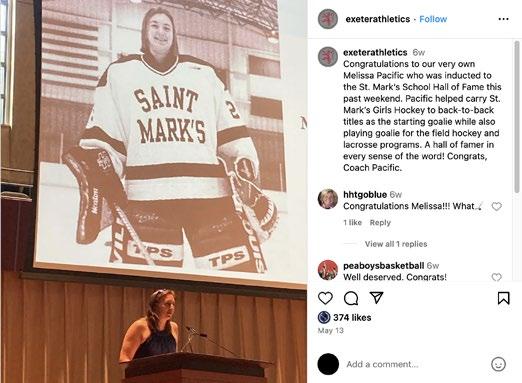
NEW ENGLAND PREPARATORY SCHOOL ATHLETIC COUNCIL








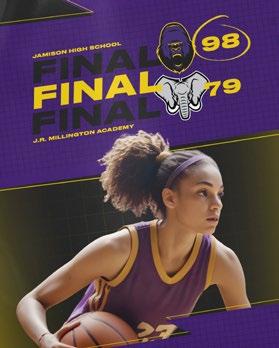






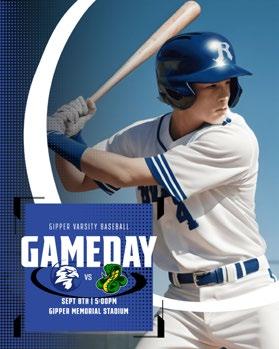





New England Preparatory School Athletic Council
2023–2024
President
Ryan Frost Cardigan Mountain School
Vice-President
Tim Joncas Westminster School
Secretary
Lisa Joel Phillips Andover Academy
Treasurer
Jim Smucker Berwick Academy
Co-Directors of Championships
Jamie Arsenault New Hampton School
Bob Howe Deerfield Academy
Lisa Joel Phillips Andover Academy
Director of Classifications
Sean Kelly The Wheeler School
Coordinator of Diversity, Equity and Inclusion
Lamar Reddicks Milton Academy
Past Presidents
George Tahan Belmont Hill School
Bob Howe Deerfield Academy
Jamie Arsenault New Hampton School
Mark Conroy Williston Northampton School
Martha Brousseau Greenwich Academy
Middle School Representatives
Rob Feingold The Fay School
Amber Kuntz Beaver Country Day School
District I Representative
Stefan Jensen Hyde School
District II Representatives
Tara Brisson Tilton School
Jenna Simon Holderness School
Connor Wells Brewster Academy
District III Representatives
Betsy Kennedy Pingree School
Jen Viana Cushing Academy
Sean Kelly The Wheeler School
Andrew Mitchell Lexington Christian Academy
District IV Representatives
Mike Marich The Frederick Gunn School
Mo Gaitán Pomfret School
Communications Specialist
Laurie Sachs The Rivers School
“NEPSAC” and the NEPSAC logo are registered trademarks of the New England Preparatory School Athletic Council and may not be used or displayed without permission.
New England Preparatory School
as a
15 In the Deep End: Williston’s Dale Neuberger Behind the Scenes at the Olympics
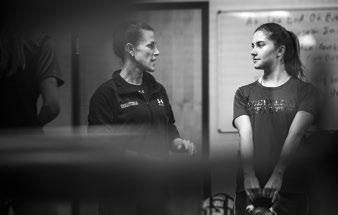



24 Gatorade Players of the Year

18 Stronger Together: Deerfield’s Fitness Program

30The History of the Frederick Gunn School’s Athletic Fields 40 Canterbury Alumnus Returns as Guest Lecturer


29 Keeping up with Rivers’ Athletics Interns
35 Going the Distance: Mik Aoki on Life Lessons and Coaching
42What are Wearables and do Athletes Need Them?
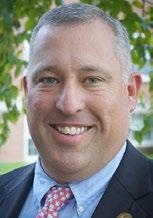
reetings to all, and happy summer! I hope this note and NEPSAC News find you all doing well and finding time to rest, relax, and recharge. I hope you are also making time to do some things for yourself and your loved ones while planning for the 2024-2025 school year. While the NEPSAC Board had its last officially scheduled meeting of the 2023-24 academic year in May, we have met several times to take care of NEPSAC business and help keep schools’ appeals and questions moving forward.
This spring, NEPSAC hosted championships in boys’ and girls’ track, boys’ and girls’ tennis, girls’ golf, and girls’ water polo. In addition to this, All-NEPSAC teams were selected and announced. Thank you to our Coaches Associations, and to Laurie Sachs and Sean Kelly, for all their work pulling these lists together. As we move forward, spring sports coaches’ associations are working on expanding our spring championship offerings. As you work toward this, please work through proposals with your association and AD liaisons first. Once they pass the association, please run them by the NEPSAC Directors of Championships for feedback and support, then send them along to the NEPSAC board for review and hopeful expansion. These have been hard to pull off in the past due to the different graduation timelines and the busy schedule of each school’s spring calendar. Despite these challenges, there is hope to bring spring championships to life for all sports.
Recently, NEPSAC and the girls’ and boys’ basketball coaches’ associations hosted three successful and well-attended basketball showcases this summer. The NEPSAC Board is also helping to bring together several representatives from each district to facilitate a discussion around our current and possible adjustment to our out-of-season coaching policy. The committee will meet a few times this summer and into the fall to work on putting together a new proposal for the greater good of all NEPSAC. Please send forward any thoughts or proposals you may have to me so I can be sure they are shared with the committee. We hope to have new guidelines for release at the November annual meeting.
I hope you all enjoy the latest issue of NEPSAC News. Thank you to Laurie Sachs for putting it together. Please share it with your community, and please continue to share all of your NEPSAC stories with Laurie as they continue to inspire us all and the continued growth of our great organization.
All the best, Ryan Frost
NEPSAC schools? Send the details to communications@nepsac.org and we’ll put it in the next issue.
by Jim Smucker, Berwick Academy, NEPSAC Treasurer
Thank you for your continued support and efforts this year.
Beginning on July 1, 2024 all NEPSAC, District and Coaches Associations dues will be available to be paid on online and all dues need to be paid by October 15th.
To be most efficient it is important that schools only create one account when making their payments. If you don’t remember your login information, simply click on the “Forgot your username or password?” link to enter your email address to receive instructions to reset your password. Remember to check your spam/junk folder for these instruction emails.
Please be aware that there is a processing fee to off-set our cost with every online transaction. We are not able to refund processing fees, so please be diligent about this process and your record keeping.
If you already have a Username and Password, go to ‘View My Account’ and enter your credentials to log in. After logging in, you will have access to ‘Payment History.’ Use the available filters to view ALL of them or choose any date range or period.
Please continue to update your school information in the online directory with any changes that you might have. It is extremely important that we have accurate contact lists of our athletic departments for a variety of communications. The online system allows for the most efficient way to collect information. Examples of use: Our coaches associations, athletic trainers, schedulers, sports information directors, and equipment managers all need accurate email lists for their important communications.
Contact Laurie Sachs communications@nepsac.org if you have any questions.
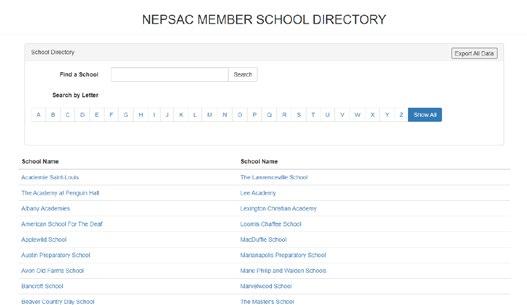
by Amy Wiggins ATC, LATC; SMAC chair
Happy Summer! I hope you are enjoying some well-deserved rest and relaxation!
SMAC will be sending guidelines for AT coverage to the NEPSAC Board per their request. This information will be divided by state regarding Athletic Training laws and what individual sports mandate AT coverage. We all are aware of nationwide shortage; however, we know the only way to keep our athletes safe is to follow best practices. We will look for ways to help schools who do not have proper coverage and share ideas on how to retain ATs in Secondary Schools. This is a topic the NATA SSAT Committee has worked on this year and as soon as the NATA Executive Board gives the ok to release our paper, I will forward to all. The paper is titled “Athletic Trainers Job Satisfaction and Retention Keys to Ensuring Student Athletes Health and Safety.”
Please review the SMAC Recommendation for Hockey - 2024-2025 Season
Beginning in 2024, and after the November meeting, SMAC will use the NEPSAC Online Payment Portal to collect fees for professional development events that the group would like to organize and have attending members pay a fee to cover the associated costs. For events like these, SMAC will coordinate the budget and expenses and then bill the attending schools. This aligns with how NEPSAC charges for, collects, and pays for tournament expenses in other NEPSACgoverned associations.
The SMAC Committee will continue to inform members as we progress. We are very happy about this and hope to offer more programing, opportunities and growth to all of NEPSAC Athletic Trainers.
A reminder to all schools to contact fellow ATs of the school you will be traveling to. Home team, please share your EAP and
what you will have available for away teams (water, AED etc.) and remember to have EAP available on game day!
I want to thank our SMAC Committee Members: Grady Congleton, Catie Moulton, Nicole Pease, Zach Kershaw, Sandy Snow, Kelly Griffin Brown, Grace Hobbes, Richard Drew, Meredyth Joly, Dr. Amy Patel, Dr. John Bassi and our liaison Sean Kelly for their time and dedication to ensure the health and safety of all NEPSAC students . I am personally thankful that no one commented on my crazy emails, requests and texts throughout the year which I know are enjoyable to read and allowed the opportunity for much laughter. Please follow us on INSTAGRAM: @ NEPSAC_SMAC
Enjoy the warm weather! Amy Wiggins and the SMAC Committee smacchair@nepsac.org



Tilton School We had a front row seat to the northern lights on Friday night! Check out these views as this geomagnetic storm passed through our campus.






School Friday night lights. Shout out to Ms.
for capturing the Aurora Borealis over campus on Friday night!


Salisbury School We don’t often see the #auroraborealis in the Northwest Corner skies, but tonight was an impressive exception to that rule!
Holderness School (middle left) Students and faculty witnessed an amazing display of the aurora borealis above campus last night, thanks to the strongest solar storm since 2003!
Concord Academy (bottom left) Our campus was lit up in the most magical way this weekend as students witnessed the breathtaking northern lights! Photo: Rodolfo Wang ’26.


Taft School The Northern Lights! A rare and stunning phenomenon captured above our campus last night by William Yang





Tabor Academy
to

School
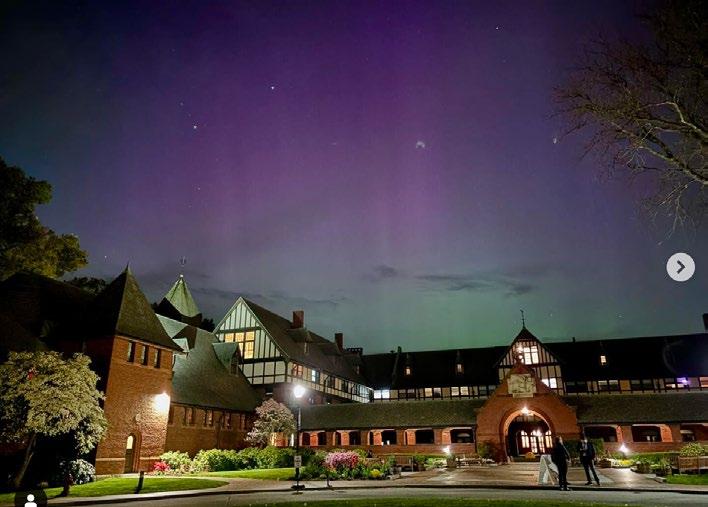

www.nepsac.org

Robert A. York passed away peacefully on April 24, 2024 at his home in Greenfield, MA, surrounded by his wife and children. He was 77 years old. Bob had been battling five unrelated cancers since 2008. He was born on February 20, 1947 to the late Ray and Alyce York of Concord, NH.
Bob graduated from Bishop Brady High School in 1966 and received his B.A. in English from Belknap College in 1970. He married the former MaryAnn Hyde in 1975 in Concord. Bob and MaryAnn had two sons, Brendan R. York (wife Amy) of Westford, MA, and Andrew W. York. They have three granddaughters, Ella M, 18, Maddie D. 17, and Sarah R. 15, all of Westford.
Beside his parents, Bob was predeceased by two brothers, Matthew in 1941 and Thomas in 1952; his Aunt Kathryn Daley and Uncle Bob Gorham; cousins Richard and John Mahon as well as his beloved grandparents Concord Fire Capt. Matthew Gorham and his wife Alice.
Beside his wife and children, Bob is survived by his cousins, Virginia Daley Mahon, Barbara Gorham Lenox, and Cathy, Eileen and Martin Mahon.
In 1970 Bob began a 42-year career with Newspapers of New England, first as a sports writer for the Concord Monitor. As a new college grad, he often sought out advice from the late Ruel Colby, a seasoned and and well-respected NH sports writer at the Monitor. Bob loved covering local and college sports. He especially enjoyed covering the Concord Eastern Olympics, a semi-pro hockey team. Bob left Concord for Florida and became a part-time writer for the Sarasota Herald Tribune. He would later move on to a full time job at the Bradenton Herald. He covered the Pittburgh Pirates and one of his first assignments was to write a story about the Roberto Clemente’s tragic death in a plane crash. He enjoyed his baseball work, but missed covering New England hockey, both college and professional, so when the late George Wilson of the Concord Monitor called and asked him if he would be interested in a sports editors job at the Recorder, he jumped at the opportunity to return to New England. He served as sports editor for 11 years and would earn eight N.E. Associated Press Awards for Sport Page Presentation before moving over to the news desk as a copy editor. Sports writing was always his greatest love and he always said he worked with some the most dedicated and talented coaches and athletes in Franklin County, such as the late Bill Budness, the late Patsy and Ralph Collins, the late Joe Spadafora, of Mahar Regional, the late Vi Goodnow of Frontier, Jim Smith and Jim Lindsey from Deerfield Academy, Doug Welenc, Tom Suchanek, Mike Duprey, Doug Weiss and many others.
Bob had been a contributing writer to the Deerfield Acadamy Alumni magazine for many years. He so enjoyed covering Deerfield athletes, past and present and loved researching stories he thought would be of interest to alumni. He also wrote for their website. He
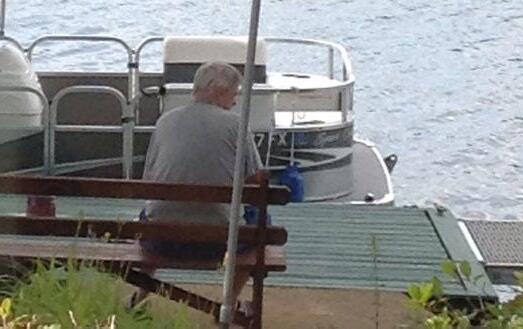
would continue writing for Deerfield until 2020. He wrote stories for several other prep schools as well, including Northfield Mount Herman and Milton Academy. Bob was a writer for the high school hockey paper, Hockey Night in Boston, for several years covering elite hockey players from Western Mass.
Bob was a writer for the New England Preparatory School Athletic Council (NEPSAC} for the last eight years. He used his deep knowledge of athletics to write over 50 articles for NEPSAC, which touched on student accomplishments, coaching awards, and notable alumni. Over the years, Bob interviewed Olympians, professional athletes, sports broadcasters, hall of fame athletes, national championship winning coaches and even General Mark A. Milley, 20th Chairman of the Joint Chiefs of Staff.
Bob loved spending time with his family at their summer home on Lake Winnisquam in NH. He would often sit out on the dock at dusk watching the beautiful pink sunset and say he hoped heaven looked just like this.
THE NEPSAC EXECUTIVE BOARD WOULD LIKE TO THANK BOB YORK, NOT ONLY FOR HIS INCREDIBLE WRITING FOR OUR ORGANIZATION FOR EIGHT YEARS, BUT FOR HIS SENSE OF HUMOR, KINDNESS, AND ABOVE ALL, HIS UNBELIEVABLE STRENGTH AND COURAGE.
Bob enjoyed golf, reading and any activities with his children and grandchildren.
Bob’s most meaningful assignment lies ahead of him. Because of his unique and challenging medical history, he applied to be part of the Anatomical Gift Program at the Geisel School of Medicine Dartmouth College, for medical research. His hope was that he might help advance new treatments for cancer patients in some small way.
Bob had so much gratitude for the doctors and the medical teams that took care of him over the years. His family wishes to thank Dr. Laurence Klein, Gage Azeez and Meghan Wheeler in Greenfield, Dr. Rocco Addante, Dr. Joseph Paydarfar, Dr. Alan Hartford, Dr. Garrett Wasp, and Catherine Anton at Dartmouth and the countless nurses, medical students and medical professionals.
A funeral mass was held Saturday, May 11 at Blessed Sacrament Church in Greenfield.
Find a collection of Bob’s NEPSAC articles here
by Sean Kelly ’02, P’35, Athletics Director
In October of 2022, Wheeler School honored Konique Ballah ’98 as she was inducted into our Athletics Hall of Fame. It was wonderful to see Konique’s excitement, along with that of her friends and family, and to recognize and share her many accomplishments with the Wheeler community. Yet, it was equally as enjoyable and fascinating to listen to her share the story of our Track & Field Program.
Like many other Wheeler folks, I knew the legend of Konique, who is often affectionately referred to as the “Godmother of Track at Wheeler.” Her undeniable skill and passion helped jumpstart our Track & Field Program in the mid90s. However, it was a simple observation that she made the night of her Hall of Fame induction that resonated with me and made me reflect on the totality of Wheeler’s Athletics Program: its history, success, purpose, and continued growth. What was her statement? “I haven’t been to the farm in 25 years. Look at this place all of it, it’s incredible. You know, we didn’t even have a track then, right?”
And here we are in 2024.
It’s hard to believe so much has transpired in the last quarter century at the Wheeler Farm (and incredible to see what lies ahead!). Baker Field


and Track, Van Norman Field House, and Godley Field. As our athletics facilities have grown, so has the Track & Field Program, which has certainly experienced a great deal of change and success over the last quarter century as well. In that time, Wheeler has helped launch the collegiate careers of dozens of talented and dedicated track and field standouts. Simultaneously, the program has cultivated an environment for novice studentathletes looking to try something new and different.
At the center of this current success is Coach Nessa Molloy. She arrived at Wheeler in the spring of 2022 to direct our Track & Field and Cross Country Programs, and her presence has been immediately impactful for so many of our student-athletes.
In her short time as head coach, she helped reestablish a competitive Cross Country Program
that former Coach Tom Wharton P’29, P’27, P’29 helped put in place during his tenure, and she has also provided consistency and excitement to our indoor and outdoor Track & Field Programs.
“I want to win, of course,” Coach Molloy recently told me. “But my vision is to build a deep program with athletes who buy into what we are doing. I want Wheeler’s student-athletes to be dedicated, regardless of talent.”
Perhaps the Warriors’ 2023 spring and fall seasons are the best examples of that vision. At the NEPSTA Division III Track Championship in May, Coach Molloy’s group claimed 11 AllNEPSAC selections in a variety of events, including the 4x100m, 4x400m, 100m Dash, 200m Dash, Javelin, 100m Hurdles, 300m Hurdles, and High Jump. The fall featured some additional success and excitement with the Boys Cross Country
team finishing in second place at the Eastern Independent League Championship and falling short of the league title by a mere two points. The Girls Cross Country team capped off their championship meet with their most successful day of the season at the most important time. The teams’ strong efforts led to All-League selections for four Warriors: Reid Wemple ’26, Evan Atwood ’25, Zach Crowthers ’26, and Ashton Carson ’27.
“The beauty of [cross country and track] is that everyone gets to compete,” Molloy added. “If you put the work in, you will improve. There is no bench. No hiding behind someone else. This is so beautiful to me; that even though there are varying talents, we are all equal out there every day.”
In watching Coach Molloy work with our student-athletes, it is clear that she embodies the very best of Wheeler. The track and trails (and sometimes Blackstone Boulevard) are her classroom, and she reinforces the same standards and expectations present in our exemplary academic spaces. She does so not only with intimate knowledge of the sport (she was a scholarship runner at Providence College), but she does so with zest, humor, and passion. Coach Molloy has also committed to the philosophy that her team is a place for everyone as long as they’re committed to putting the effort into being their best self.
“Our potential is what is most exciting to me,” said Molloy. “I am looking forward to building that championship team. But more importantly, I love the daily grind. I love practice. I love getting to know the athletes. I love seeing them support each other. I love seeing them learn the value of hard work and commitment.”
When I asked her what she loves most about coaching at Wheeler, Coach Molloy was quick to respond. “Wheeler is such a unique community that gives so many brilliant opportunities to its students,” she said. “I am so happy that I get to be a part of this.”
And Wheeler is very happy to have her and her Cross Country and Track & Field Programs as part of its community, too.
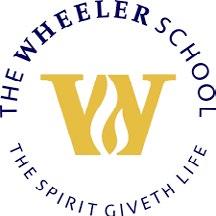
We are thrilled to announce that Anna Knechtel, Director of Athletics at St. Luke’s School, has been honored with the prestigious Donald Bagnall Secondary School Athletic Trainer of the Year Award by the Connecticut Athletic Training Association. This esteemed recognition celebrates Anna’s outstanding contributions and unwavering dedication to promoting athletic training within the secondary school setting.
As an advocate for sports medicine education, Anna initiated the Sports Medicine course at St. Luke’s School, providing students with the opportunity to explore sports medicine as a potential profession. Anna’s commitment to her students’ growth extends beyond the classroom as she actively engages them in discussions about the profession of athletic training and encourages their pursuit of higher education in the field.
Anna’s influence as an athletic trainer extends beyond the Hilltop. As the Fairchester Athletic Association Athletic training president, she played a pivotal role in bringing together athletic trainers within the league to address pertinent issues, find solutions, and mentor emerging professionals. Her contributions have also extended to the collegiate level, where she serves as a preceptor for athletic training students at Quinnipiac University and Sacred Heart University. Anna also serves as the Medical Director for Stamford Youth Football, providing

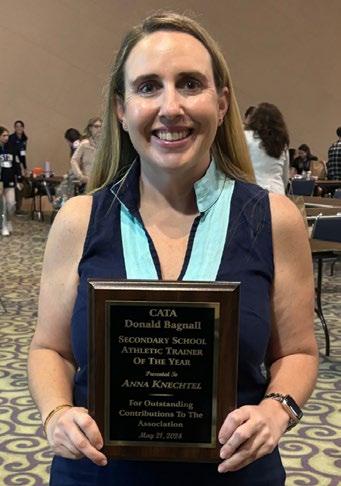
young athletes and families with essential athletic medical care.
In her application for the award, Anna emphasized her dedication to creating a safe and welcoming environment for her school community. “I strive to build relationships with studentathletes that go beyond physical challenges or injuries,” she wrote. “My goal is to create an inclusive athletic training room where everyone feels heard and supported in addressing their physical, social, and emotional needs.”
This steadfast commitment to ensuring the well-being of others is what sets Anna apart and makes her truly deserving of this special recognition for athletic training professionals.
Got news to share with other NEPSAC schools? Send the details to communications@nepsac.org and we’ll put it in the next issue.
by Gary Sheppard
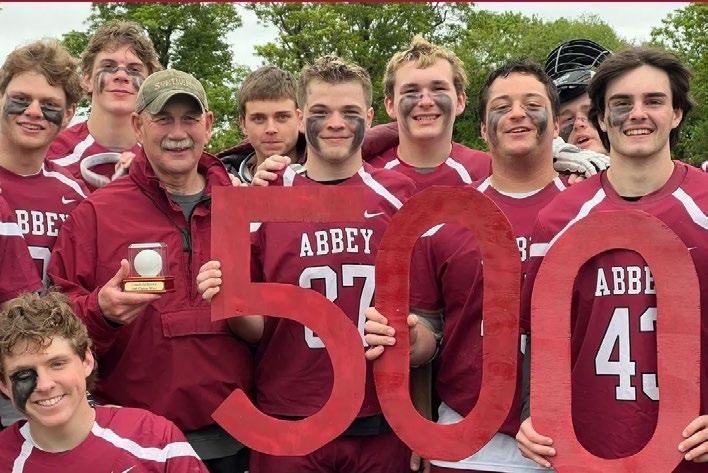
Head Coach Alfred “Al” Brown secured his 500th career victory on May 18 when the boys’ varsity lacrosse team defeated Austin Prep 17-1.
Brown joined the Portsmouth Abbey community in 2000, bringing with him a distinguished background as both a player and a coach. A standout athlete at CW Post College (Long Island University), he earned All-American honors twice and served as team captain his senior year. With an impressive 47 years of coaching experience at the collegiate and high school levels, he is highly respected in the lacrosse community.
At the collegiate level, he was honored as the national Division III Coach of the Year in 1990. He has led nine Portsmouth Abbey teams to lacrosse league championships and was named Coach of the Year by US Lacrosse, the governing body of lacrosse in the United States, in 2010 and 2013. He was also named Eastern Independent League Coach of the Year in 2008, 2011, and 2022. In November 2022, Brown was inducted into the National Interscholastic Lacrosse Coaches Association (NILCA) Hall of Fame.
Off the field, his commitment to excellence is matched only by his devotion to family. He and his wife, Linda, reside in Portsmouth, Rhode Island, and Rangeley, Maine, where they cherish
visits from their three children and five grandchildren.
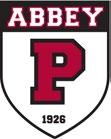
Reflecting on Brown’s remarkable milestone, Portsmouth Abbey Director of Athletics Christopher Milmoe said, “Al Brown crossing the 500-career win mark is an unbelievable achieve- ment. It speaks to his commitment to the sport of lacrosse and Portsmouth Abbey. The impact he has had on the Abbey community is immeasurable.”
When asked his thoughts on winning 500 times, Coach Brown responded with characteristic modesty and focus, “I am fortunate to have been surrounded by excellent coaches, student athletes, player families and my wife Linda and my children. Their support has been the key to my being a coach for 47 years. My goal has always been to help my players grow to be responsible and caring people, to love the game and to understand the value of being a great teammate. Winning is important. And I am proud of all the people that have played a part in my career. I am blessed to have spent half of my coaching career at Portsmouth Abbey. It is a special place.”
by Kristine Hendrickson
The Rhode Island Lacrosse Officials Association (RILOA) presented Portsmouth Abbey Boys’ Varsity Lacrosse Coach Al Brown with the Scott A. Shemenski Distinguished Service to Lacrosse Award at halftime during the Division I game of the Rhode Island Interscholastic League State Championships on Saturday, June 1.
An Army veteran, teacher and head lacrosse coach at Bishop Hendricken High School, Scott A. Shemenski also co-founded the Rhode Island Youth Lacrosse League in 1989 and remained a coach in that program until his death in 2001. He helped organize the RIIL’s interscholastic lacrosse program, directed the Rhode Island Indoor Lacrosse League, and was treasurer of the Rhode Island Chapter of U.S. Lacrosse.
In recognizing Brown, RILOA Vice President E.J. McQuade III noted his profound influence on players throughout his 47-year career, particularly at the high school level, and the shared spirit between the two coaches. “Scott played such an important part in the growth of lacrosse in Rhode Island, and you very much embody the service to lacrosse on and off the field – not to mention 500 wins,” he wrote in an email to Brown on May 28.
Brown secured his 500th career victory on May 18 when the boys’ varsity lacrosse team defeated Austin Prep 17-1. He joined the Portsmouth Abbey community in 2000, bringing a distinguished background as a player and a coach. A standout athlete in college, he earned All-American honors twice and served as team captain his senior year. With an impressive 47 years of coaching experience at the collegiate and high school levels, he is highly respected in lacrosse. Many of his players go on to play at the collegiate level.
RILOA’s recognition of outstanding coaches, teams, and players during the state championships has been well-received by the Rhode Island Interscholastic League (RIIL) and the entire lacrosse community. Presenting the awards in a prominent setting has been a force multiplier for recruiting lacrosse officials by telling the story of RILOA’s work off the field to grow the game and celebrate the accomplishments of those playing or supporting the players.
Be sure to hit the links under each sport to see the All-NEPSAC athletes
BOYS TRACK AND FIELD
All-NEPSAC List
All-NEPSAC List
BOYS LACROSSE
All-NEPSAC List
GIRLS LACROSSE
All-NEPSAC List
NEPSAC All Time Champions List
Division 1 Phillips Exeter Academy
Division 2 Middlesex School
Division 3 Groton School
All-NEPSAC List
GIRLS TRACK AND FIELD
Division 1 Loomis Chaffee School
Division 2 The Governor’s Academy
Division 3 Wilbraham & Monson
All-NEPSAC List
GIRLS GOLF
Phillips Exeter Academy
All-NEPSAC List

“All your scheduling needs in one place”!
Key Features
Logistics Calculator
Rentals, Practices, Facilities, Contests
Grid and Table View
Season Rollovers (no re-typing)
Create,Print and Email
o Contracts, Master Schedules, Change Notices, Reminders
Integrate d Google/Outlook Calendar
Built-in Weather Forecast
Customization Included
And, much, much, more!
High Street Solutions

https://highstreetsolutions.weebly.com/ Mark B Perkins markbperkins@gmail.com
802.457.7383
GIRLS TENNIS
Class A Hopkins School
Class B Kingswood Oxford School
Class C King School
All-NEPSAC List
BOYS TENNIS
Class A Phillips Academy Andover
Class B Roxbury Latin School
Class C Concord Academy, Kents Hill School
All-NEPSAC List
GIRLS WATER POLO
Williston Northampton
All-NEPSAC List
Do you need a handbook, directory or magazine? How about a postcard, invitation or stationery? Or a program brochure, fundraising appeal or search piece?
Are you overwhelmed? Do you even know where to start?
Let me help. I have over 25 years of experience with school publications and printing production, and I am accustomed to tight deadlines and equally tight budgets.
I can help you figure out what you want, pull the pieces together and deliver a final product you will be thrilled to share with parents and alumni.

THRIFT ~ HONESTY ~ PRIDE







by Geoff Smith ’07
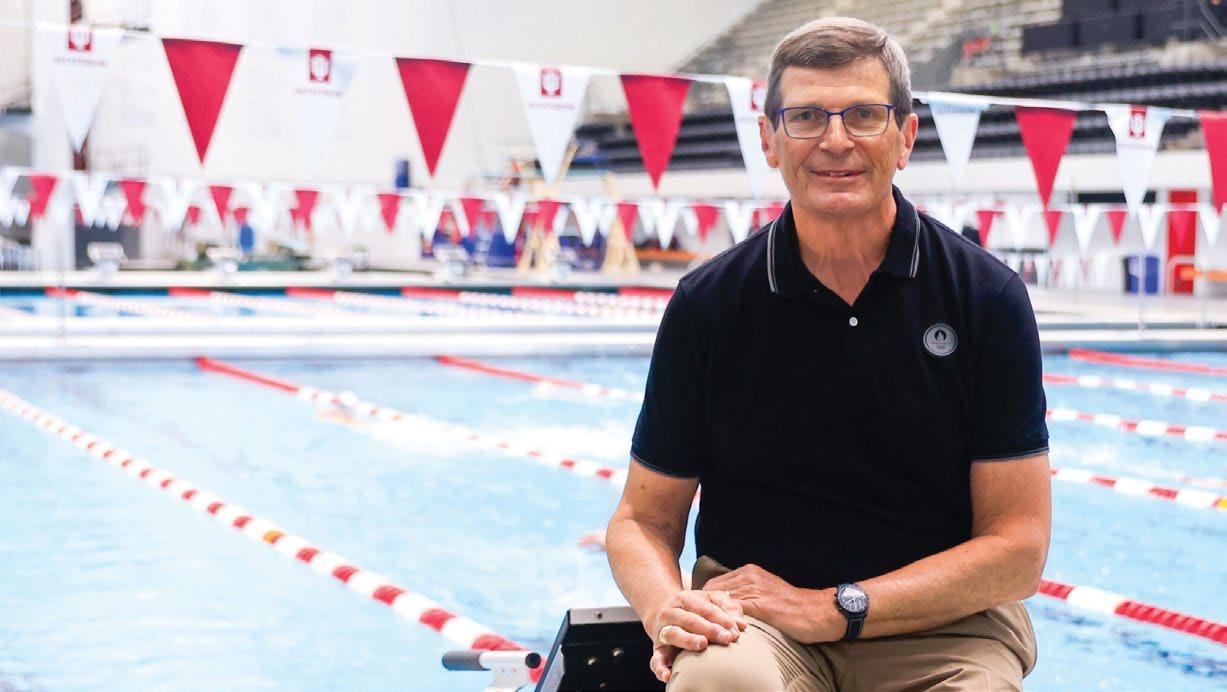
Next summer, when Dale Neuburger ’67 steps on the pool deck at the Summer Olympics in Paris, France, he will be laser-focused on making sure the events go perfectly. When you’re the Technical Director for the swimming events at an Olympiad, there’s no margin for error. But in the back of his mind, Neuburger will also be thinking of his mom, Iris. Because without her influence, Dale might not be standing on that pool deck in the first place.
As a teenager growing up near Buffalo, New York, Neuburger was passionate about swimming, and as he approached high school, his mom encouraged him to pursue the sport further at Williston Academy with then-legendary swimming Coach Wilmot Babcock. “Williston was her idea,” Neuburger says. “I can remember the initial conversations about it and thinking, ‘What’s boarding school?’ But she really wanted me to have this great experience.” Neuburger loved being in Babcock’s program, and his contributions on campus ultimately earned him the 1967 Wilmot S. Babcock Award—one he still proudly displays in his home today.
“Williston is a special place,” say Neuburger, who now lives in Indianapolis, Indiana. “None of what I’m doing today would have been possible without the great foundation, the great background, that I had under the leadership of Coach Babcock.”
Neuburger’s path to being one of the key figures in swimming today—Treasurer of World Aquatics, the governing body for world swimming, water polo, and diving—has been long and winding. First hired to oversee school district pools in Syracuse, New York, Neuburger then became the Assistant Athletic Director at Indiana
University, running the school’s natatorium (pool) and tennis and track facilities. In 1990, he was elected to the board of directors for USA Swimming, a position he held through 2018.
Neuburger describes his career as “serendipitous.” When he started in Syracuse, Neuburger was given an opportunity that he admits he probably wasn’t ready for. Same when it came to serving on the board of USA Swimming. “I didn’t even really know what the board did,” Neuburger says. However, he clearly excelled at both. Neuburger was elected President of the group in 1998, serving for four years, then became the United States’ representative to World Aquatics in 2000. That election opened the globe to Neuburger, and he has served as the organization’s Vice President, its Treasurer, and the Chair for the Development Commission. This last role is focused on growing the sport globally, and takes him around the world to help establish youth swimming systems and to watch competitions where future Olympians may emerge.
Amazingly, all of this is Neuburger’s volunteer job. Until recently, his 9-to-5 gig was working for consulting firms that
provided client services to North American cities and sports organizations. “Sales is not my strong suit,” Neuburger says, “but it’s easier when you know you have the opportunity to provide the best possible conditions for athletes to excel and for coaches to have some of the best moments of their careers.”
Which brings the story back to the Olympics. At his first, in 1976, he and his wife, Heidi, drove from Syracuse to Montreal, and stayed at a $3-a-night campground. By 2004, he was serving as Deputy Chef de Mission for the U.S. Olympic delegation in Athens, Greece, responsible for the 500-plus-member U.S. delegation and leading the athletes out during the opening ceremony. But it was when Neuburger first served as Technical Delegate for swimming in the 2008 Olympics that he had his most intense moment: Michael Phelps winning the 100-meter butterfly by .01 seconds. Neuburger was one of the people who had to explain to media, fans, and competitors why Phelps won, when it appeared as if his Serbian counterpart had touched the wall first. “One of the things I say now when talking about the Olympic Games to our officials is, ‘Without putting any unnecessary fear in your hearts, there’s a couple billion people who care about what happens in this environment,’” he says. “And then the enormity of what the responsibility really means hits them.”
For all the Olympics fanfare—this coming summer Olympiad will be Neuburger’s fifth as Technical Director and twelfth overall— Neuburger hasn’t lost sight of his mission: to build up aquatic sports. In his role as Treasurer for World Aquatics, he has helped ensure the sport’s financial viability, with development funding rising from $250,000 a year in 2009 to $12 million in 2024. As he plans to retire in 2027, he is thinking about what he has left to accomplish. “It has been a good run,” he says, “but now it’s about leadership development and succession planning. I really get a lot of joy being at the junior championships where you are helping to motivate young leadership in our sport. For me, that’s a real passion now, and I know the sport is in good hands.”

Neuburger’s role at the Olympics has given him the opportunity to present awards to a litany of prestigious swimmers, including Michael Phelps, pictured here at the 2016 Olympic games in Brazil
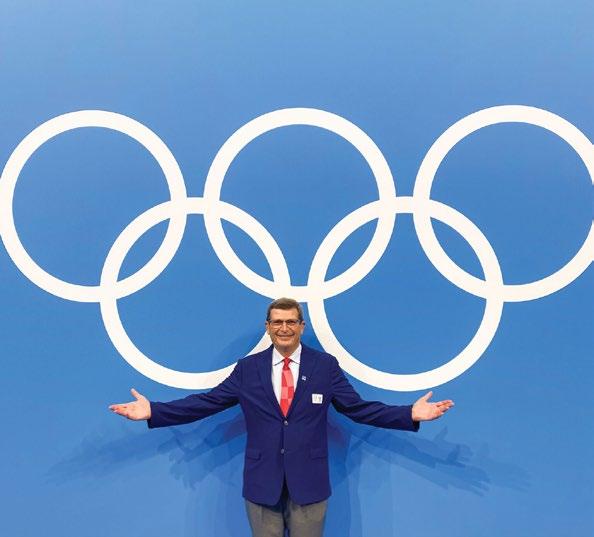
“One of the things I say now when talking about the Olympic Games to our officials is, ‘Without putting any unnecessary fear in your hearts, there’s a couple billion people who care about what happens.’”
So when you turn the TV on for the Paris Olympics next summer, keep an eye out for Neuburger in the corner of your screen. While his mom never got to see Dale stand on an Olympic swim deck, her presence is with him still. “When I stand there at the Olympics, I always I think of her giving me this background,” he says. “This is the result today.”
Shortly after this article was written, Neuburger shared the news that he is being honored with the George M. Steinbrenner III Sport Leadership Award by the U.S. Olympic & Paralympic Endowment, a nonprofit supporting organization for the U.S. Olympic & Paralympic Committee. The award, named after the late New York Yankees owner and former vice president of the Olympic Committee, is given annually to a member of the U.S. Olympic and Paralympic family who has made outstanding contributions to sports through management, sport-organization endeavors, or the enhancement of competitive opportunities. Previous winners include: Pat Summitt, Martha and Bela Karolyi, the 1992 Men’s Olympic Basketball Team, and last year’s winner, Peter Westbrook.
“I am honored beyond belief,” said Neuberger. “Totally unexpected.”
Neuburger will be feted for the award on December 13 at the New York Athletic Club in New York City. Along with Neuburger, the USOPE will also honor Mary Lou Retton with the William E. Simon Award, and Bruce Baumgartner with the General Douglas MacArthur Award.


B a y S t a t e G a m e s i s a
5 0 1 ( c ) ( 3 ) n o n - p r o f i t
o r g a n i z a t i o n t h a t w a s
e s t a b l i s h e d i n 1 9 8 2 t o
h o s t M a s s a c h u s e t t s ’ o w n
O l y m p i c - s t y l e a m a t e u r a t h l e t i c c o m p e t i t i o n
F U T U R E L E A D E R S
S C H O L A R S H I P
T h e F u t u r e L e a d e r s S c h o l a r s h i p a i m s t o
i d e n t i f y y o u n g m e n a n d w o m e n w h o w i l l
b e t o m o r r o w ’ s l e a d e r s S i x s c h o l a r s h i p s a w a r d e d a n n u a l l y

R A M
H i g h s c h o o l a m b a s s a d o r s p r o m o t e
w i t h i n t h e i r s c h o o l s t o g a i n l e a d e r s h i p
a n d m a r k e t i n g e x p e r i e n c e

S U M M E R G A M E S
E a c h y e a r t h e S u m m e r G a m e s f e a t u r e s
7 , 0 0 0 a t h l e t e s c o m p e t i n g i n 3 0 s p o r t s
A t h l e t e s o f a l l a g e s a n d a b i l i t i e s
r e p r e s e n t o v e r 3 0 0 M a s s a c h u s e t t s
c o m m u n i t i e s e a c h y e a r R e g i s t r a t i o n
o p e n s i n M a r c h 2 0 2 4
W I N T E R G A M E S
A t h l e t e s c o m p e t i n g i n F i g u r e S k a t i n g ,
C u r l i n g , a n d M a s t e r s I c e H o c k e y w i l l
r e p r e s e n t h u n d r e d s o f c o m m u n i t i t i e s f r o m M a s s a c h u s e t t s a s w e l l a s M a i n e ,
Ne w H a m p s h i r e , V e r m o n t a n d R h o d e
I s l a n d .
B a y S t a t e S u m m e r G a m e s H i g h S c h o o l
S h o w c a s e s c o n s i s t o f e i g h t s p o r t s ,
w h e r e t h e s t a t e o f M a s s a c h u s e t t s i s
d i v i d e d i n t o s i x r e g i o n s . E a c h r e g i o n a l
t e a m i s l e d b y a v o l u n t e e r c o a c h i n g
s t a f f



I n a d d i t i o n t o s p o r t s
p r o g r a m m i n g , B a y S t a t e G a m e s
p r o v i d e s h e a l t h , e n r i c h m e n t , a n d
e d u c a t i o n a l p r o g r a m s t o b e n e f i t
t h e l i v e s o f o u r t h o u s a n d s o f
p a r t i c i p a n t s a n n u a l l y
V O L U N T E E R
O P P O R T U N I T I E S
E a c h y e a r , B a y S t a t e G a m e s r e l i e s
o n h u n d r e d s o f g e n e r a l
v o l u n t e e r s t o h e l p o p e r a t e t h e
S u m m e r G a m e s
IN THE STRANDBERG FITNESS CENTER, AND ADJACENT TO IT IN THE ATHLETIC TRAINERS’ ROOM, AWAITS AN ENTIRE SUPPORTING CAST READY TO HELP STUDENTS ON THEIR ATHLETIC JOURNEYS.

There are some things all Deerfield students know about the Wachsman Athletics Complex: For good luck, clank the ring on the hitching post out front; tap the ‘D’ on the wall near the locker rooms; and never step on the Seal. These rituals, like many of the best things about Deerfield, are rooted in tradition, and Deerfield’s “healthy mind in a healthy body” attitude toward student well-being is no exception. It began with Headmaster Frank Boyden, who firmly believed that athletics were an integral part of a Deerfield education, and he wasn’t shy about sharing his lesson plan. In the December 1942 issue of The Atlantic, former principal of Phillips Exeter, Lewis Perry, who was also a colleague and friend of Mr. Boyden’s, even referenced “the Boyden Method:” “Work ’em hard, play ’em hard, feed ’em up to the nines, and send ’em to bed so tired that they are asleep before their heads are on the pillow.”
Today, participation in the cocurricular program in the form of an organized afterschool activity is still required of every student throughout the year, and it’s still an essential component of a Deerfield education, helping to cultivate the habits required to live a healthy, balanced life through athletic, artistic, and civic pursuits. In the Strandberg Fitness Center, and adjacent to it in the athletic trainers’ room, awaits an entire supporting cast ready to help students on their athletic journeys.
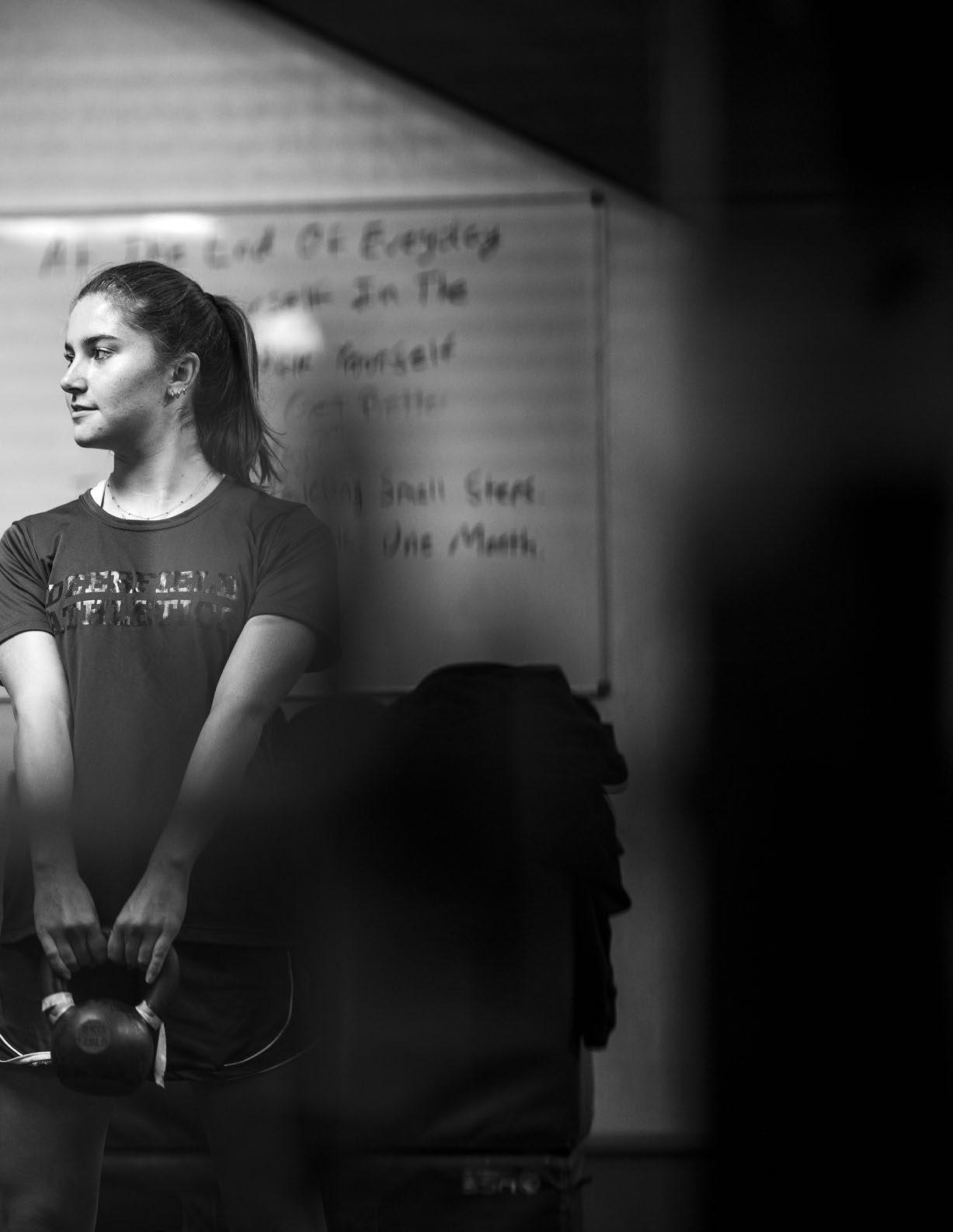
by Daniella Vollinger | Photography by Tom Kates

“FROM TEAM LIFTS TO FITNESS CENTER ORIENTATIONS, TO INDIVIDUAL PROGRAMMING— FOR ANYONE WHO REQUESTS IT— TO THE ALL-FEMALE MORNING LIFT CLUB, AND SO MUCH MORE, THESE TWO HAVE EMBEDDED THEMSELVES IN DEERFIELD’S CULTURE, AND PROVIDE A GREAT SERVICE TO ANYONE WHO’S FIT OR ASPIRING TO BE MORE FIT.”
BOB HOWE ON THERIAULT AND BREAULT


“What’s great is that when students come into the fitness center, we’re the first ones they see. We get to check in, greet everyone, and see how people are doing,” says Fitness Center Manager and Head Strength and Conditioning Coach Emma Theriault who, alongside her colleague Chris Breault, runs Deerfield’s Strength and Conditioning program. Their expertise is available to all students, employees, and employee families. “Our space is dedicated to the physical portion of a healthy lifestyle, and we focus on how to fit healthy habits into everyone’s day,” Theriault says. “We also focus on how to maximize those habits in terms of stress management and athletic performance,” she adds, noting that the strength and conditioning offerings are part of a broader conversation about health and wellness that students are immersed in through their health classes, in events sponsored by the Student Life Office, and in the services offered through the Chen Health and Wellness Center.
The first step of any regimen for students and employees alike is an orientation process. The strength and conditioning coaches discuss the importance of cardiovascular health and fitness, as well as run through the options, expectations, and rules of the facility, offering them the choice to receive a program tailored to their goals.
“A lot of kids come in with high hopes for the fitness center, but they hit a wall in terms of what to do or where to start,” observes Coach Breault, who works with Theriault to provide an inclusive atmosphere in the space. He emphasizes that although gyms can be intimidating, everyone starts by learning technique and form.
“In recent years, Coach Theriault and Coach Breault have exponentially increased the availability of the space to the Deerfield community,” says Director of Athletics and Cocurricular Program Bob Howe. “From team lifts to fitness center orientations, to individual programming—for anyone who requests it—to the all-female morning lift club, and so much more, these two have embedded themselves in Deerfield’s culture, and provide a great service to anyone who’s fit or aspiring to be more fit.”
Each season (or term) the strength and conditioning coaches see between 100 and 150 students. They also assist athletic teams by helping to identify opportunities to improve performance, and they work closely with coaches to set up workouts so that each individual athlete is being challenged. “My personal mission is to help every athlete in their fitness journey, making sure everything they’re doing is correct in terms of exercises, sets, and reps, or in the progression of the exercises they’re doing,” says Breault, who also emphasizes the importance of discipline and consistency. “We want them to be the best athletes they can be, but we also want them to be the best versions of themselves.”
“WE WANT THEM TO BE THE BEST ATHLETES THEY CAN BE, BUT WE ALSO WANT THEM TO BE THE BEST VERSIONS OF THEMSELVES.”
— STRENGTH AND CONDITIONING COACH CHRIS BREAULT

“We approach athletes from a holistic perspective,” explains Theriault, “emphasizing sound mechanics and movement elements, and considering the unique demands of their schedules; our athlete-centered, sport-specific model strives to prioritize efficiency and effectiveness while aiming to maximize our impact within the limited time constraints of competitions and practice schedules. Our in-season athletes are looking to maintain strength to keep their performance higher and reduce chances for injury.”
Part of that equation is making sure everybody knows the importance of sleep and recovery, as well as hydration and diet, and Theriault, who has also taught health classes at Deerfield, likes to help student-athletes put it all together. “We want to make sure that we are looking at the big picture and we’re not just addressing strength and conditioning. We’re looking at the athlete and figuring out how we can make the biggest impact,” she says.


With an office located in the lower level of the fitness center, Athletic Trainers Bob Graves, Kate Parker, and Gabriela Biscottini may be less visible than their teammates upstairs on a day-to-day basis, but when injuries happen, they spring into action. During practices or a games, Head Athletic Trainer Graves or Assistant Trainers Parker and Biscottini are at the ready, either on the sidelines or a call away. During away games, they are on standby and coordinate with the coaches and trainers from other schools to ensure that any injured Deerfield athlete gets the greatest degree of attention. Technically part of the Chen Center team (Health Services), the trainers view themselves as a health resource for the entire community.
“I see the athletic training program as an extension of the health center,” says Graves. “Our goal is to provide the highest standard of care possible to the school community. As professionals, we’ve wrestled with the term ‘athletic training’ for years; we’re definitely healthcare professionals, and at Deerfield, a major part of our role revolves around athletics and cocurriculars.”
Creating a space that is welcoming for the entire community is also a top priority for this team. “I find that whether it’s a rec squash player, a fourths soccer player, a JV kid, or a varsity athlete, a lot of kids are comfortable coming into our office, and we give the same standard of care and treatment to everybody,” says Biscottini. “It helps to creates a safe and inclusive environment— to know that it doesn’t matter what level of sport you’re playing—or even if you’re playing a sport—we’re going to work with you and get to know you just the same as everybody else.”
Parker shares the sentiment. “Our mission is to provide the best quality care to each student, and to treat them as individuals, as opposed to seeing everybody as an athlete,” she says, noting that the model they employ is one in which the first trainer to see a student will continue to treat that student, ensuring a continuity of care. “Seeing kids go from injury through the rehab process and then return to play is gratifying.”
THEY ALSO ASSIST THE ATHLETIC TEAMS BY HELPING TO IDENTIFY OPPORTUNITIES TO IMPROVE PERFORMANCE, AND THEY WORK CLOSELY WITH COACHES TO SET UP WORKOUTS SO THAT EACH INDIVIDUAL ATHLETE IS BEING CHALLENGED.
NUMBER OF STUDENTS THE STRENGTH AND CONDITIONING COACHES SEE EACH SEASON/TERM

The common thread among all those who work in the Wachsman is how much genuine satisfaction they derive from helping young people. They talk about the importance of building character through overcoming injury or adversity, or through developing a commitment that requires some self-discipline, or the lifelong impact of developing healthy exercise, diet, and sleep routines.
“The strength of any program lies with its leaders,” remarks Howe, noting that during his tenure, he has seen Deerfield increase its level of commitment to the cocurricular program by broadening its scope and seeking out extraordinary coaches and supervisors. “When Deerfield talks about its ongoing mission to promote and facilitate the community’s well-being, health, and safety, it starts with good hires, and in these five you can see what a difference they make. At Deerfield, we hire well and then give them the space and the support to be excellent!”
And at the close of each day, Breault can be seen walking around the fitness center—straightening out the plates, making sure the barbells are perfectly aligned, and the dumbbells are readable and organized. He says it’s a gentle reminder to the community: “Whoever comes in the next day sees that we take pride in what we do here.”


The Gatorade Player of the Year award was established in 1985 to recognize the nation’s most elite high school student-athletes for their athletic excellence, academic achievement and exemplary character.
In each of the 50 states and the District of Columbia, one Gatorade State High School Player of the Year is chosen in each of the following sports: football, volleyball, boys and girls cross country, boys and girls basketball, boys and girls soccer, softball, baseball, and boys and girls track and field.
One winner from each of the twelve sports is chosen from each state and the District of Columbia.
The Gatorade State Player of the Year award winners are evaluated and selected on the basis of three criteria:
» Athletic Excellence - Standout performance in their respective sport made at the high school, club, national or international levels of competition.
» Academic Achievement - Review of GPA and class rank, as well as SAT and ACT scores, and academic honors distinctions.
» Exemplary Character - Commitment to sportsmanship, character and community through membership and participation in positive activities.
In 2023–2024, 12 NEPSAC athletes from 11 schools in Connecticut, Massachusetts, New Hampshire, and Rhode Island were named Player of the Year in football, boys soccer, boys cross country, boys and girls basketball, and baseball.

Myles Craddock of Moses Brown School is the Rhode Island Football Player of the Year. Craddock is the first Gatorade Rhode Island Football Player of the Year to be chosen from Moses Brown School.
The 5-foot-10, 187-pound senior running back rushed for 1,504 yards and 21 touchdowns this past season, averaging 10.1 per carry and leading the Quakers (7-4) to a berth in the Division III quarterfinals. In his final three regularseason games, which Moses Brown needed to win to reach the postseason, Craddock rushed for 553 yards and scored
10 total touchdowns. Defensively, he recorded 38 tackles and an interception, forced fumble and blocked punt.
The student senate co-president, Craddock has volunteered locally at the Camp Street Food Pantry, and on behalf of Play 60, an NFL youth flag football program. He also has donated his time as a peer leader for ninth-graders at Moses Brown.
“Myles is different from most running backs because he is also a great receiver out of the backfield, and as a slot guy,” said Pilgrim High School head coach Blake Simpson. “Myles has great ball protection and I believe what makes him different from most backs is he’s usually at top
speed as soon as he touches the football.” Craddock has maintained a 3.48 GPA in the classroom. He remains undecided about a collegiate destination.

Ryan Puglisi of Avon Old Farms is the Connecticut Football Player of the Year. Puglisi is the second player to be chosen from Avon Old Farms.
The 6-foot-3, 210-pound senior quarterback passed for 1,758 yards and 14 touchdowns this past season, completing 66.9 percent of his throws for 10.0 yards per attempt to lead the Winged Beavers to a 7-3 record in the
New England Preparatory School Athletic Council (NEPSAC). Puglisi also rushed for 361 yards and three touchdowns, averaging 5.9 yards per carry. A Nike Elite 11 finalist, he is ranked as the nation’s No. 112 prospect in the Class of 2024 by ESPN.
Puglisi has volunteered locally on behalf of the Special Olympics and has helped raise money for cancer research through his work with A Shot For Life, a sports-based non-profit organization based in Massachusetts.
“Ryan is a tremendous competitor and high-character kid with an elite arm,” said Hotchkiss School head coach Dempsey Quinn. “He plays the game the right way and is fun to watch on the field. He makes all the throws; he’s a stud. From a talent perspective, he’s in a league of his own.”
Puglisi has maintained a B-plus average in the classroom. He has signed a National Letter of Intent to play football on scholarship at the University of Georgia next fall.
Puglisi joins previous NEPSAC Connecticut Football Player of the Year Wilfredo Aybar (2020-21, Cheshire Academy).
Alfred Debah of Milton Academy is the Massachusetts Boys Soccer Player of the Year. Debah is the third player to be chosen from Milton Academy.

The 6-foot-1, 165-pound junior midfielder and forward led the Mustangs to a 19-1-2 record and the New England Prep School Athletic Council Class A Tournament championship this past season. Debah scored 16 goals and passed for six assists, contributing one of each in Milton’s 2-0 win over the Taft School in the title game. He was the NEPSAC Class A Player of the Year and a First Team All-New England selection by the New England Soccer Journal.
A member of the International Student Club and the African Students Association at Milton Academy, Debah has donated his time as a mentor for younger students at his school.
“Alfred is one of the most multi-talented players to come through New England in a number of years,” said Chris Kane, head
coach of Milton Academy. “He combines that versatility with an incredible work rate and desire to improve. This year, he made the transition from midfield to striker and became the single-most explosive player in all of New England.”
Debah has maintained a B-plus average in the classroom. He has made a verbal commitment to play soccer on scholarship at Wake Forest University beginning in the fall of 2025.
Other NEPSAC honorees from Massachusetts include Kaan Inanoglu (2022-23, Milton Academy), Augustine Boadi (2021-22, Northfield Mount Hermon School), and Khamari Hadaway (2019-20, Northfield Mount Hermon School).

Alvaro Medrano Lopez of The Woodstock Academy is the Connecticut Boys Soccer Player of the Year. Medrano Lopez is the first Gatorade Connecticut Boys Soccer Player of the Year to be chosen from The Woodstock Academy.
The 6-foot-1, 180-pound junior goalkeeper led the Centaurs to a 15-01 record and the Prep Premier League Tournament championship this past season. Lopez conceded just seven goals and recorded 11 shutouts. A member of the Guatemalan Under-20 Men’s National Team, he won the Prep Premier League Golden Gloves Award as the league’s top goalie and was named First Team All-State by the Connecticut Soccer Coaches Association.
Lopez has volunteered locally at an eldercare facility and has donated his time to multiple community service initiatives through his church.
“Alvaro made several key saves in games against us and several games that I watched,” said Evan Prybutok, head coach of the Phelps School. “While Woodstock would have still had a good overall season without Alvaro, I don’t think they have the same type of success and I do not believe they go undefeated.”
Lopez has maintained an A average in the classroom. He will begin his senior year of high school this fall.
Other NEPSAC Connecticut players include Kelvin ‘KK’ Baffour (2021-22), and Sammed Bawa (2019-20), both of Taft School, among the state’s list of former award winners.
Byron Grevious of Phillips Exeter Academy is the New Hampshire Boys Cross Country Player of the Year for the second time. Grevious is the first Gatorade New Hampshire Boys Cross Country Player of the Year to be chosen from Phillips Exeter Academy.

The state’s returning Gatorade Player of the Year, the 5-foot-7, 125-pound senior improved upon his 2022 campaign this past season by winning the Nike Cross Nationals Northeast Regional Championships to earn First Team AllRegion honors. Grevious followed up with a Second Team All-American performance by taking 11th at the NXN Final. Ranked No. 10 in the 2023 Dyestat 100, he also won the NEPSTA Division 1 state title, leading the Big Red to the team championship.
Grevious has volunteered on behalf of the Special Olympics and a Connecticutbased organization serving at-risk youth. He’s also donated his time to Exeter’s student-run radio station.
“State champ, regional champ and AllAmerican: It’d be hard to ask much more of Byron Grevious in 2023,” said Rich Gonzalez of PrepCalTrack. “He also broke the meet record and the Manchester Invitational for good measure and seems destined to make a name for himself on the Left Coast at Stanford next season.”
Grievous has maintained an A-minus average in the classroom. He has signed a National Letter of Intent to run on scholarship at Stanford University this fall.

Tam Gavenas of Phillips Academy is the Massachusetts Boys Cross Country Player of the Year. Gavenas is the first Gatorade Massachusetts Boys Cross Country Player of the Year to be chosen from Phillips Academy.
The 5-foot-7, 120-pound junior took bronze at the national Foot Locker Cross Country Championships this past season, clocking a time of 15:16.6 to earn First Team All-America honors. Gavenas, who took second at the NEPSTA Championships with a personal-best time of 15:06.0, placed seventh in the featured Eastern States Championships at the Manhattan Invitational. He also took fourth at the Foot Locker Northeast Regionals in 15:07.0.
A Barbara Landis Chase CAMD Scholar at his school, Gavenas founded Lunar Plexi, an organization geared toward high schoolers that undertakes various environmental projects inspired by distance running. He has volunteered locally as a member of the Mass Audubon Society, serves as a campus tour guide and donates his time on behalf of the Memorial Hall Library.
“Tam Gavenas’ legs were simply magical in the postseason, delivering the best finish by a Massachusetts runner at the Foot Locker Nationals meet in 26 years,” said Rich Gonzalez of PrepCalTrack. “During the regular season, broke the old meet record in finishing second at the Manchester Invitational, and his top 10 placing in the Eastern States race of the Manhattan Invitational was further proof he’s a rising star.”
Gavenas has maintained a B-plus average in the classroom. He will begin his senior year of high school this fall.
as a shooter this year. She’s just different.” Adams has maintained a B average in the classroom. She has signed a national letter of intent to play basketball on scholarship at the University of Miami this fall.

Orlagh Gormley of Dexter Southfield School is the Massachusetts Girls Basketball Player of the Year. Gormley is the first Gatorade Massachusetts Girls Basketball Player of the Year to be chosen from Dexter Southfield School.
signed a national letter of intent to play basketball on scholarship at Providence College this fall.
Gormley joins recent Gatorade Massachusetts Girls Basketball Players of the Year Grace Oliver (2022-23) and Caroline Ducharme (2020-21 & 201920), both of Noble & Greenough School, and Taina Mair (2021-22, Brooks School) among the state’s list of former award winners.
Three NEPSAC boys basketball players were honored this year, the most in any one sport.

Jaylen Harrell of CATS Academy Boston is the Boys Basketball Player of the Year. Harrell is the first Gatorade Massachusetts Boys Basketball Player of the Year to be chosen from CATS Academy Boston.

Ahnay Adams of Tilton School is the New Hampshire Girls Basketball Player of the Year. Adams is the second Gatorade New Hampshire Girls Basketball Player of the Year to be chosen from Tilton School.
The 5-foot-6 senior guard averaged 19.8 points and 7.2 assists per game this past season, leading the Rams (29-3) to the Class AA New England Preparatory School Athletic Council (NEPSAC) title game. Adams also averaged 6.4 rebounds and 3.8 steals per game while shooting 47 percent from 3-point range. Ranked as the nation’s No. 39 recruit in the Class of 2024 by espnW, she is now a three-time Gatorade Player of the Year and concluded her prep basketball career with 1,776 points.
A member of Tilton’s student government, Adams has volunteered locally on behalf of the Special Olympics, the Spaulding Youth Center and Meals For Hope.
“Ahnay is so good and she gets better every year,” said Adrian Griffin, head coach of Loomis Chaffee High School. “I watched her process things in real-time in transition (very quickly) and once she gets into the paint, you’re done. She improved
The award, which celebrates the nation’s top high school athletes for excellence on the court, in the classroom and in the community, distinguishes Gormley as Massachusetts’ best high school girls basketball player. From CEOs and coaches to star athletes, Gatorade Player of the Year winners showcase the power of sport, touting an all-star group of alumni that includes Candace Parker (2003-04, 2002-03 & 2001-02, Naperville Central High School, Ill.), Paige Bueckers (2017-18, Hopkins High School, Minn.) and Juju Watkins (2022-23 & 2021-22, Sierra Canyon School, Calif.).
The 5-foot-6 senior guard averaged 22.1 points and 9.2 rebounds per game this past season, leading the Shields (20-4) to the semifinals of the Class AA New England Preparatory School Athletic Council (NEPSAC) tournament. Gormley also averaged 7.1 assists and 4.8 steals per game while shooting 65 percent. A two-time NEPSAC AA First-Team selection, she concluded her prep career as Dexter Southfield’s leading scorer in history with 1,801 points.
Gormley has volunteered locally with A Shot For Life, a sports based non-profit organization that funds health and cancer research initiatives. She has also donated her time as a youth basketball coach with the iHoop Academy.
“She carries that team and she’s their motor,” said Jamie Bavaro, head coach of New Hampton School. “She’s done great things for Dexter to make them really competitive. She’s composed. She’s a well-respected point guard that handles herself really well.”
Gormley has maintained a 3.62 weighted GPA in the classroom. She has
The 6-foot-6, 210-pound junior guard averaged 24 points and 7.1 rebounds per game this past season, leading the Griffins (21-10) to a berth in the New England Preparatory School Athletic Council Class AA tournament. Harrell also averaged 4.6 assists per game en route to becoming a two-time NEPSAC All-League Class A honoree. A National Prep School Invitational All-Tournament selection, he’s ranked as the nation’s No. 68 prospect in the Class of 2025 by On3.com.
Harrell has volunteered locally on behalf of the Tobin Community Center in Roxbury, Mass., and as a coach with the Wayne Selden Camp.
“Jaylen is an exceptional scorer and can really shoot the ball,” said Mike Hart, head coach of St. Andrew’s School. “He’s a tall guard, but he’s aggressive and plays great defense. He conducted himself well on the court. He’s a definite Division I guy.”
Harrell has maintained a B average in the classroom. He will begin his senior year of high school this fall.
Harrell joins recent Gatorade Massachusetts Boys Basketball Players of the Year AJ Dybantsa (2022-23, St. Sebastian’s School), TJ Power (202122, Worcester Academy), Kyle Filipowski (2020-21, Wilbraham & Monson Academy) and Dallion Johnson (2019-20, Phillips Academy).

Nojus Indrusaitis of Brewster Academy is the New Hampshire Boys Basketball Player of the Year. Indrusaitis is the fifth Gatorade New Hampshire Boys Basketball Player of the Year to be chosen from Brewster Academy.
The 6-foot-5, 192-pound senior guard averaged 14.5 points and 4.6 rebounds per game this past season, leading the Bobcats to a 27-7 record and a No. 9 national ranking by ESPN. Indrusaitis made 43 percent of his 3-point attempts and led Brewster in scoring in its first season in the National Interscholastic Basketball Conference. A 2022 FIBA U-16 gold medalist while playing for Team Lithuania, he is ranked as the nation’s No. 66 prospect in the Class of 2024 by ESPN.
Indrusaitis has volunteered on behalf of the Nida International Basketball Camp for youth players in Lithuania.
“His offensive scoring ability is impressive,” said Paul Peterson, head coach of Wasatch Academy. “He’s a three-way scorer who can pull up, hit the 3-pointer and score at the basket. They run a lot of sets and most teams try to pressure you out of the sets. You could never rattle him … He showed up in all their big games. When we did our scouting report, he was the head of the snake for their team.”
Indrusaitis has maintained a weighted 3.8 GPA in the classroom. He has signed a national letter of intent to play basketball on scholarship at Iowa State University this fall.
Indrusaitis joins recent Gatorade New Hampshire Boys Basketball Players of the Year Matas Buzelis (2021-22, Brewster Academy), Alex Karaban (2020-21, New Hampton School) and Jordan Geronimo (2019-20, St. Paul’s School).

Tyler Betsey of St. Thomas More School is the Connecticut Boys Basketball Player of the Year. Betsey is the fourth Gatorade Connecticut Boys Basketball Player of the Year to be chosen from St. Thomas More School.
The state’s returning Gatorade Player of the Year, the 6-foot-8, 210-pound senior wing averaged 23.1 points and
six rebounds per game this past season, leading the Chancellors (29-9) to a berth in the New England Preparatory School Athletic Council Class AAA championship game. Betsey also averaged 3.1 assists per game and sank 84 percent of his free throw attempts. A First Team NEPSAC Class AAA selection, Betsey is ranked as the nation’s No. 57 recruit in the Class of 2024 by ESPN.
Betsey has volunteered locally at a Hartford-area soup kitchen and by organizing a school backpack drive in his hometown of Windsor.
“He’s the most improved player we saw this year,” said Jamie Sullivan, head coach of Worcester Academy. “Everything they did revolved around him and his game has really evolved. He can put the ball on the floor, drive and defend. He does a lot of different things well.”
Betsey has maintained an A average in the classroom. He has signed a national letter of intent to play basketball on scholarship at the University of Cincinnati this fall.
Another recent NEPSAC honoree is Micawber Etienne (2019-20) of Suffield Academy)
The 6-foot-1, 210-pound senior catcher led Dexter Southfield to an 12-91 record and a berth in the Central New England Prep School Baseball League semifinals this past season. Conte batted .459 with four home runs and 15 RBI, producing an on-base percentage of .588 and an OPS of 1.375. He also made just one error on 165 defensive chances behind the plate. A New England Baseball Journal All-CNEPSBL selection, he is ranked as MLB Pipeline’s No. 146 overall draft prospect.
Conte has volunteered locally on behalf of his local church community and also provides both hitting and catching lessons to players whose families cannot afford private instruction.
“Conte shuts down the running game,” said Ryan Suchanek, head coach at Cushing Academy. “He’s a power threat in the middle of the lineup, he plays hard and he’s been a no-nonsense force at Dexter for four years.”
Conte has maintained a 3.26 GPA in the classroom. He has signed a National Letter of Intent to play baseball on scholarship at Wake Forest University this fall.

Matt Conte of Dexter Southfield School is the Massachusetts Baseball Player of the Year, the second Gatorade Massachusetts Baseball Player of the Year to be chosen from Dexter Southfield School.
Conte joins recent Gatorade Massachusetts Baseball Players of the Year Thomas White (2022-23 & 2021-22, Phillips Academy) and Josh Baez (202021 & 2019-20, Dexter Southfield School), among the state’s list of former award winners.
FOOTBALL
Myles Craddock, Moses Brown School
Ryan Puglisi, Avon Old Farms
BOYS SOCCER
Alfred Debah, Milton Academy
Alvaro Medrano Lopez, The Woodstock Academy
BOYS CROSS COUNTRY
Byron Grevious, Phillips Exeter Academy
Tam Gavenas, Phillips Academy Andover
GIRLS BASKETBALL
Ahnay Adams, Tilton School
Orlagh Gormley, Dexter Southfield School
BOYS BASKETBALL
Jaylen Harrell, CATS Academy Boston
Nojus Indrusaitis, Brewster Academy
Tyler Betsey, St. Thomas More School
BASEBALL
Matt Conte, Dexter Southfield School
Complete list of NEPSAC Gatorade Players of the Year

Leaders at every surface. Partner with Tarkett Sports for your next sports facility construction [turf, track, tennis, courts, and more]. Our experts can help guide you through the planning, design, construction, and surfacing of your project. With Tarkett Sports, nothing is left to chance.






If you attend a Rivers School varsity game, you might catch a few students on the sidelines, moving quickly to capture the action of the athletes in photos and video. With a hand in everything from photography, videography, and graphic design to video production and editing, these students— participants in the Rivers Athletics Internship Program—bring the excitement of the games to thousands of followers on the athletics social media channels and earn a sports credit at the same time.
Jacob Werrick ’16, assistant director of athletics, developed the program, now in its third full year, while balancing coaching teams and building a following on the athletics social media platforms. The first cohort started small, with borrowed cameras, and has now grown to an official program unique among ISL peer schools, with professional gear and space for interested students to gain practical experience with sports media. The application process is by sports season (fall, winter, spring) and has become increasingly competitive.
Werrick, who mentors the students in the program, says the group takes inspiration from teams at the collegiate and professional levels to develop content for Rivers’s social media channels. Cohorts meet once a week to determine media coverage for each of the games, receive student-led production-software training, and hear from guest speakers in the industry. Their final projects, a new component this year, included creating sports-specific websites, making videos, and tracking in-depth game statistics.
Evan Deede ’24, an intern since the first year of the program, has served as a mentor for the newer students and is planning a career in sports media.
“I’ve learned a lot with Premiere Pro [one of the industry’s leading video editing programs], which has helped me to elevate my work,” said Deede, who specializes in video production. “It’s all about learning what works and what doesn’t and figuring out skills on your own.”
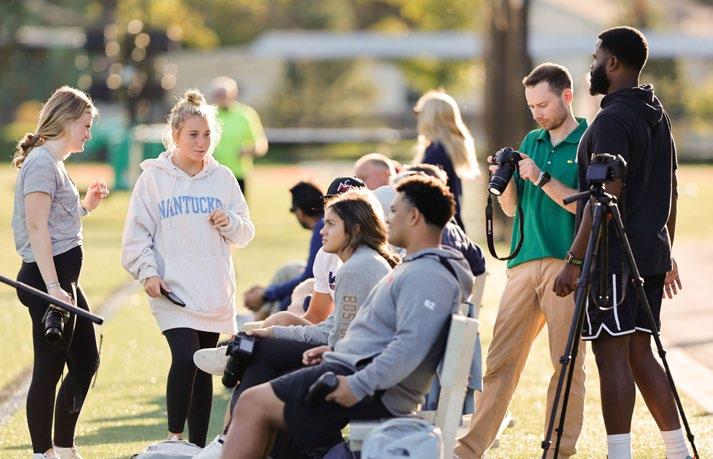
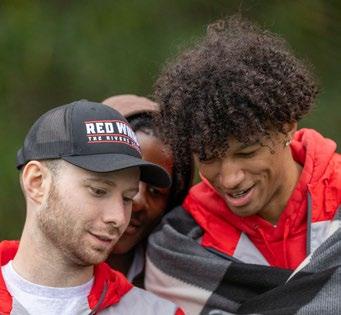
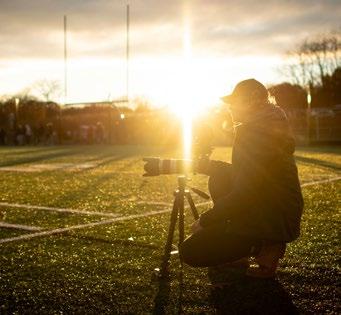
Students who participate in the Athletics Internship Program, under the guidance of Jacob Werrick ’16 (lower left), learn valuable multimedia skills and help bolster school spirit.
With students creating content for their peers, the athletics channels have been able to make closer and more authentic connections with their audience. Harper Fruhan ’24, another intern from the beginning, creates content for the TikTok channel and has also watched the evolution of the internship program. “School spirit has really elevated since we’ve been involved,” she said. “As teenagers in high school, we know what teenagers in high school are looking for.”
Part of what makes watching or playing sports exciting is the unpredictability. The world of sports media mirrors that energy, and Rivers interns are gaining valuable experience in that world, quickly responding and adapting to changing trends and technologies and bringing audiences along for the ride.
By Jennifer Clement
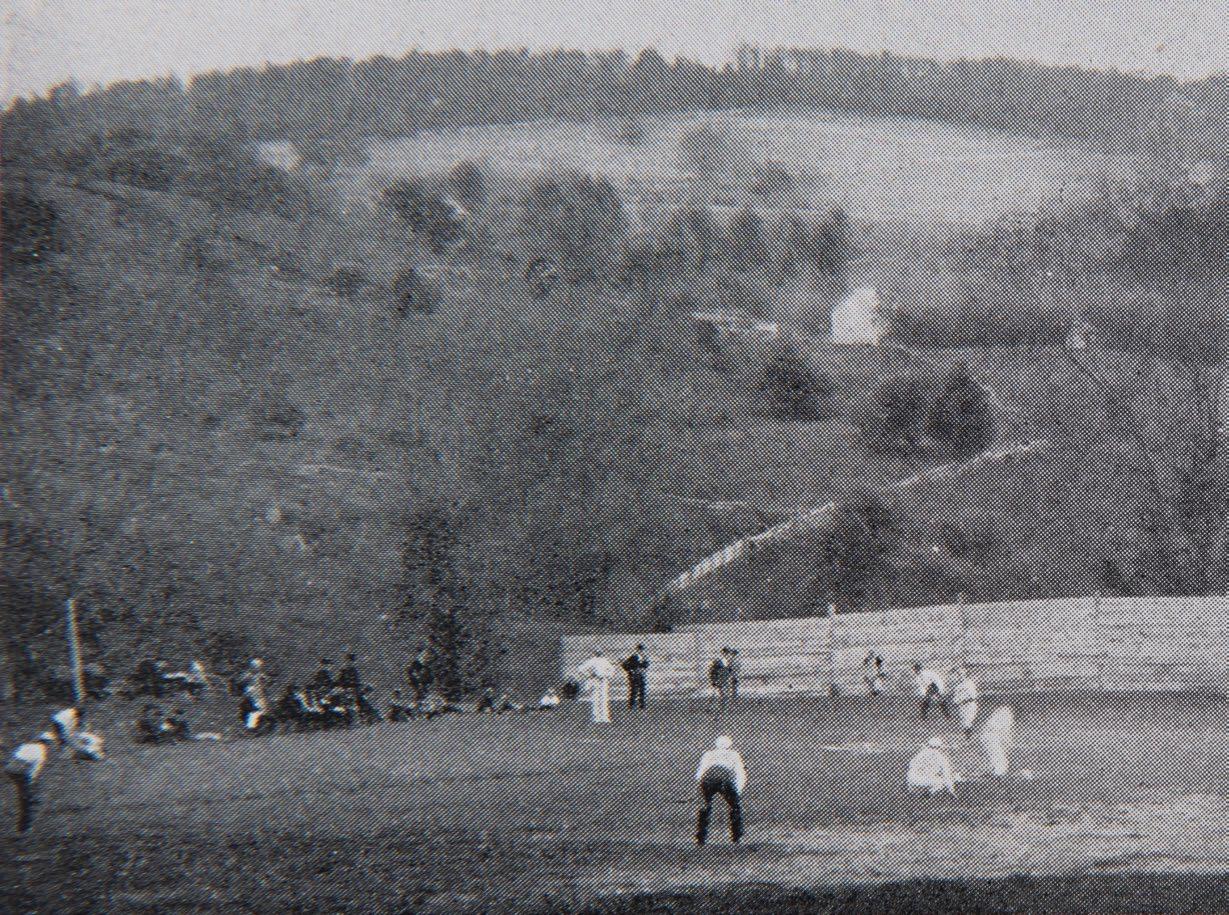
According to Mark Rhoads ’04, the school had a second baseball field “in front of the Mayflower.” This 1892 photograph from a Stray Shot Supplement, published in 1902 by The Gunnery Association, shows that field with farmland and rolling hills behind it.
As the school begins to reimagine the east side of campus, where Gunn students have played baseball, football, tennis, basketball, hockey, and other sports for more than a century, Head of School Emily Raudenbush Gum asked us to look into the Paula and George Krimsky Archives and Special Collections to learn more about the history of our athletic fields.
Highlanders know well Seth C. Landon’s 1869 photograph of a baseball game in progress on Washington Green. Gunn was among the first schools to play baseball against local teams (as early as 1859, according to Gunn Scholar Mark Rhoads ’04), and Frederick Gunn was not only an enthusiastic promoter but a participant. However, in 1881 the First Ecclesiastical Society of Washington passed a resolution that essentially banned baseball on the Green, deeming it “destructive” to the grounds, and a “danger to the traveling public.”
For the next few years, Gunn baseball was played on a building lot one quarter mile from the Green, owned by Edwin
H. and Katherine Mairs of New York. “Mr. Gunn remarked that the ball-ground might not be of the best, but that at any rate the spectators would have a beautiful view,” Adam Korpalski wrote in The Gunnery 1850-1975: A Documentary History of Private Education in America. Land records indicate that Mr. Gunn purchased eight acres on the east side of Route 47 in May 1848, when he was still living in Towanda, Pennsylvania. This was just a month after he married Abigail Brinsmade, and less than two years before they opened the school, which would indicate they were already planning for his return to Washington.
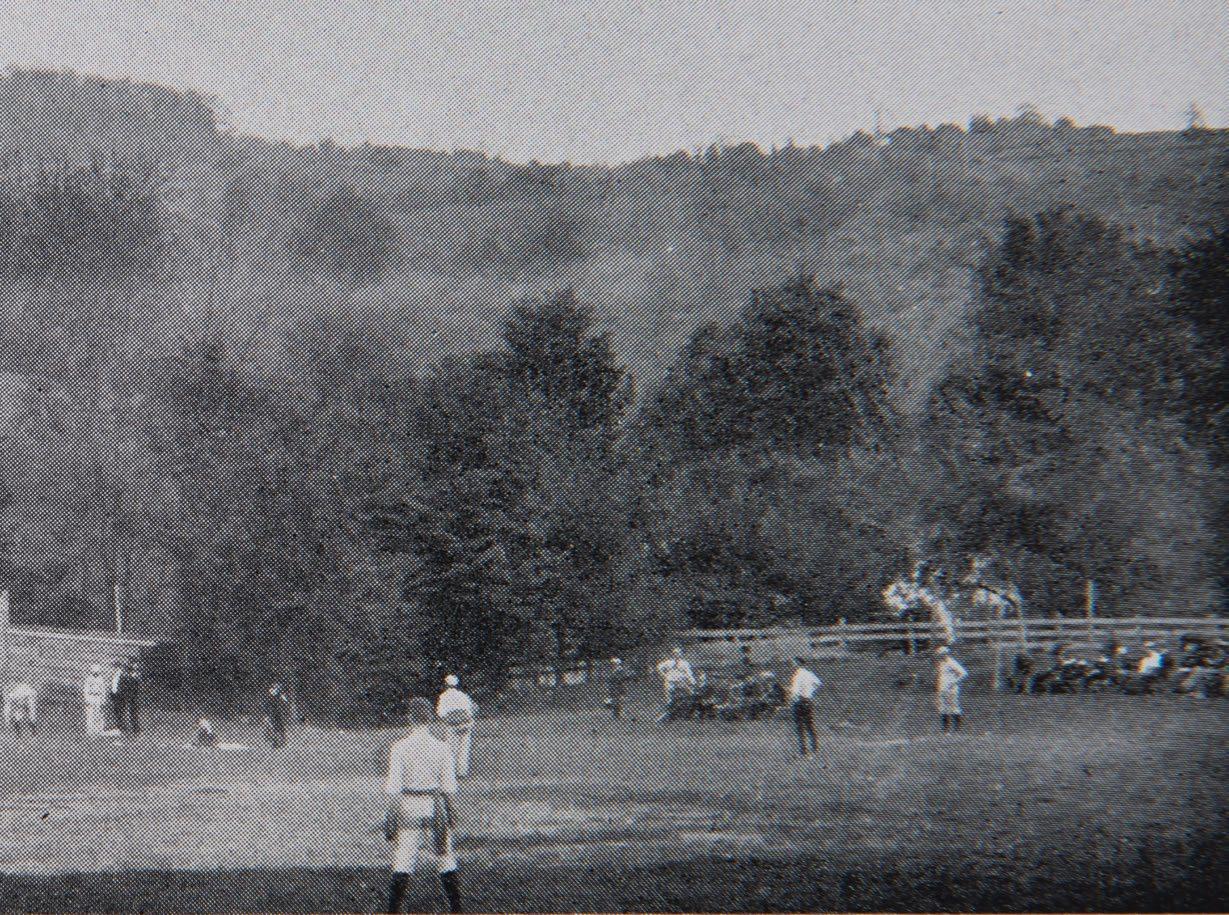
Reprinted with permission from The Bulletin of The Frederick Gunn School, Fall 2023. All photos courtesy of the Paula and George Krimsky Archives and Special Collections, The Frederick Gunn School

The School’s first gymnasium was built in the summer of 1881 on the east side of campus, possibly while Mr. Gunn was still alive. After he became the second Head of School, John C. Brinsmade purchased another 12 acres on the east side of the highway, beginning in 1884. This “meadow, situated directly across the street from the Gunnery … has since been the play-ground of the school,” Korpalski wrote. More than a century later, in 1989, the field was rebuilt and dedicated in memory of Samuel Jackson Underhill ’35 by his family, friends of the school, and alumni from the classes of 1934, 1935, and 1936.
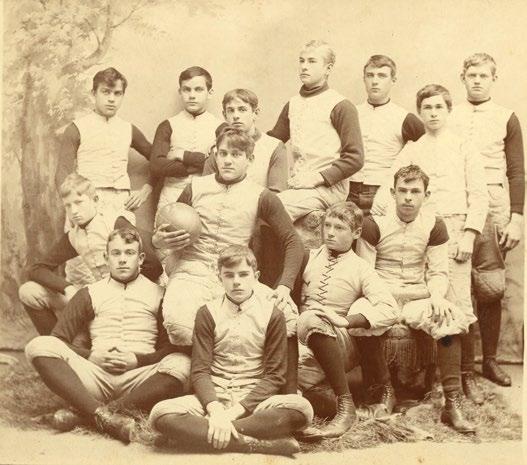
“The Gunnery Game of Foot-Ball,” published in The Stray Shot in 1888, recalled that football had been played at the school as early as 1858, and games were held on the Green. Football was also played informally on the east side of campus, succeeding baseball “as the weather compels,” The Stray Shot said in 1884. Gunn students played “the town fellows” and the season sometimes ran through Christmas. The first intramural team (above) was organized in 1892.
In June 1884, members of The Athletic Association organized “Field Sports,” which included the hundred yard dash, pole vaulting, the “hitch-and-kick” or standing high jump, the shot, for which an eight-pound dumb bell was used that year, and the “hundred yard hurdle race,” according to The Stray Shot.

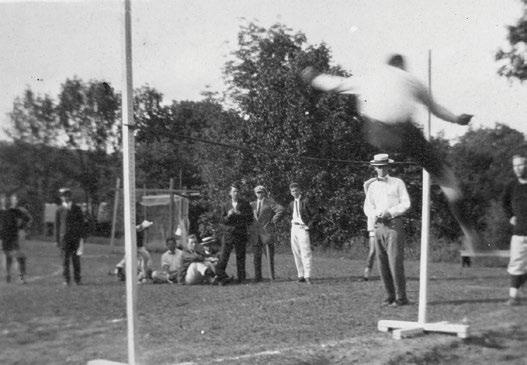

Barnes Field was dedicated in 1928 in honor of Richard Storrs Barnes, who was a student of Mr. Gunn in 1867 and 1868. The field was built through a generous gift from Barnes’ father-in-law, Alfred S. Bourne, along with four tennis courts, the bleachers, and Barnes Field House. A bronze plaque in honor of Barnes stands at the base of the bleachers. Wersebe Memorial Field was acquired by the school in 1969 from neighbors Helen Wersebe and Irma Wersebe Buxton Field, who lived in Wersebe House, now a faculty home (in the background at right). The field was dedicated in honor of their brother, Edward Ireland Wersebe, Class of 1932.

The Tennis Association was organized In April 1887. There were four tennis courts on the west side of campus at this time, including one between the Schoolhouse and Mr. Van Ingen’s (now Bourne Hall), according to The Stray Shot. This photo is of the tennis team in 1932.

Student interest in ice hockey was expressed as early as 1900. In 1904, The Stray Shot reported: “a place for a hockey rink has been chosen, at the eastern end of the ball field, which is being made ready for flooding at the approach of cold weather.”
The school was not able to formally organize a hockey team until 1905 (above), when the first game was played against Taft. A hockey rink was built at Mayflower pond in 1923, aided by the construction of a dam that students helped to build. In subsequent years, the school flooded the tennis courts for hockey, and the sport was played on local ponds prior to 1965, when an open-air rink was built at the far end of Barnes Field (where Linen Rink is today).
In 2022, The School reprinted The Master of The Gunnery in a new paperback edition under the title, The Biography of Frederick Gunn. What follows is an excerpt from the chapter, “Gunnery Sports,” written by Clarence Deming, Class of 1866, who went on to play football and baseball at Yale, and became a journalist for the New York Evening Post.
Deming recalled what it was like to play baseball on Washington Green. The Gunnery nine truly had the home team advantage on this unique ballfield. The store referenced below was built in 1773 and is today a faculty home located at 10 Kirby Road. Mr. Beecher is Henry Ward Beecher, clergyman, activist, past parent, and brother of Harriet Beecher Stowe.
“Many were the curious incidents, most of them forgotten, that from time to time gave spice to the game during its long popularity at the Gunnery, where it is still played as a systematic sport. Once in a match game, when the bases were full, a fair right-field ball was hit through the store window, and after making a lively circuit through the Yankee notions on the shelves, ended its erratic trip under a large iron safe, whence it was not dislodged for half an hour. Occasionally the ball caught in the forks of the lofty maples, and once it lodged in the church belfry. Several times in the writer’s memory it entered the church windows, compelling a long and sacrilegious hunt under the pew seats. A very funny episode once took place at a game organized among the young ladies of the village, who in those days wore hoop skirts of ample circumference, which acted as a sort of drag-net, entangling anything caught in their intricate meshes. A fair player struck a ball at the home-plate which, as she started to run, bounded into her skirts, all unobserved by her, and caught there. ‘Run, run!’ cried the spectators, and she flew around the bases, making a clean home-run before the ball dropped and rolled on the ground, to the uproarious delight of the lookers-on, including Mr. Beecher, whose keen enjoyment of the episode is recalled by many of us, and who promptly christened the little maid the ‘Belle of the Ball-ground.’”
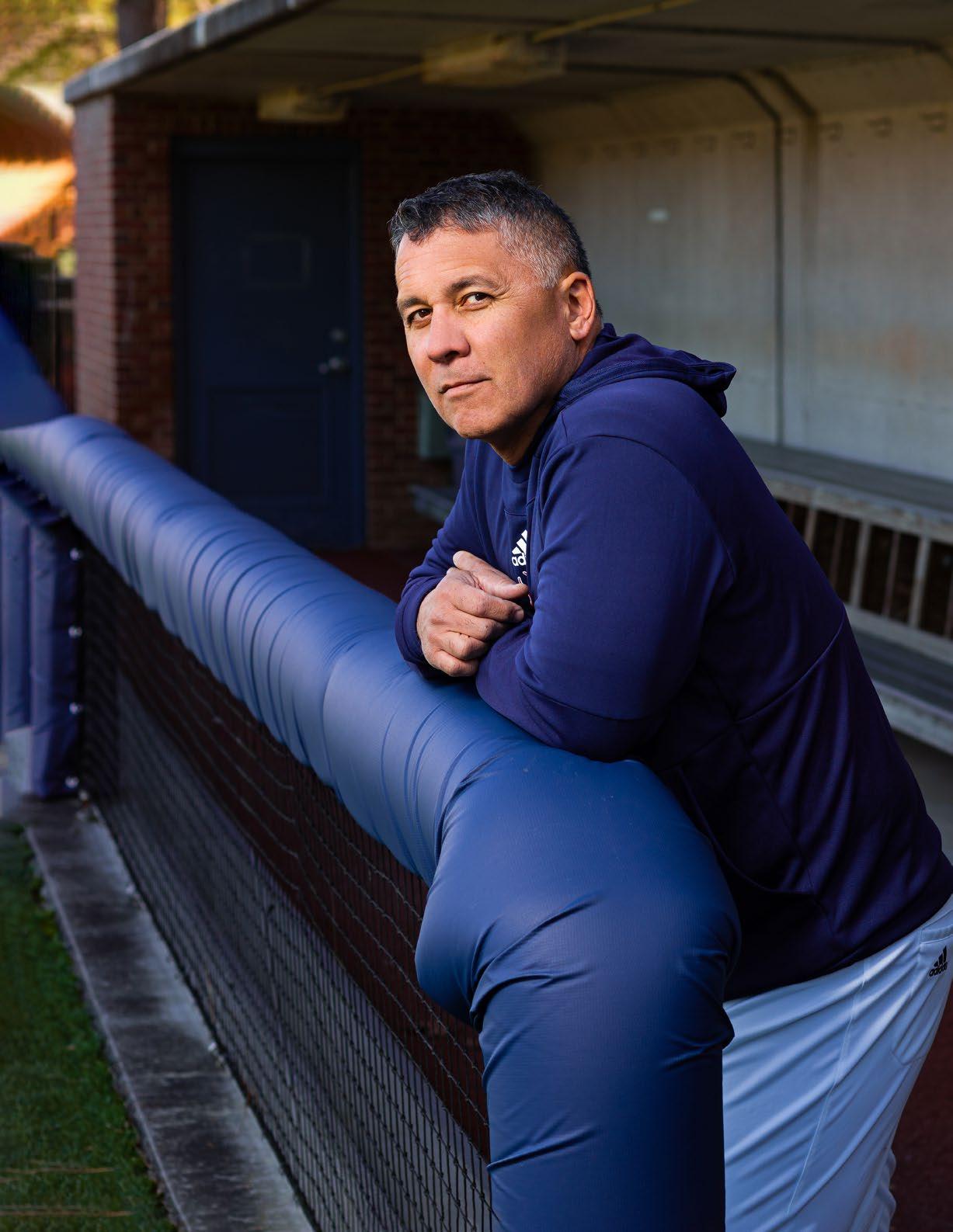

MILTON ACADEMY | MILTON, MASSACHUSETTS
MIK AOKI ’86 BEGAN HIS LOVE FOR BASEBALL AS A YOUNG BOY IN JAPAN. OVER HIS MANY YEARS AS A COACH, HE’S COME TO APPRECIATE THE IMPORTANT LIFE LESSONS HIS PROFESSION HAS TO OFFER.
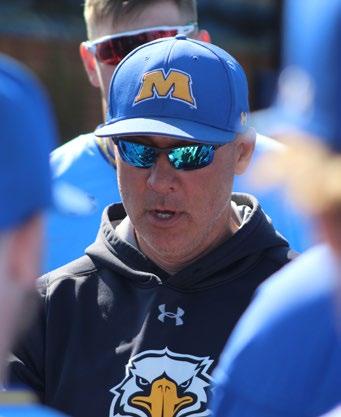
In the fourth decade of his coaching career, Aoki reflects on both the lessons he’s tried to impart and the lessons he’s learned. “In this business it’s all too easy to focus on the outcome… But it’s equally important to win the right way. To understand the journey of trying to be great at something. Because that’s where the real life lessons lie.”
Mik Aoki ’86 has spent a lifetime on the baseball diamond, as a player and as a coach. Yet he rarely spoke about the game with his mother. “For my mother, studies always came first,” says Aoki, who recently took over as head baseball coach at the University of Richmond. “She never discouraged me. But I think she would have been just as happy if I had taken up the tuba.”
Aoki’s Japanese father met his American mother on a blind date while studying in New York City. Aoki was born in Yokohama, Japan, in 1968 and first learned to play baseball in the courtyard of his family’s apartment complex in Tokyo. “We played wiffle ball at first,” he says. “And then we played with rubber baseballs called kenko balls. I used to throw that kenko ball against the apartment building wall, and then over the balconies, over the fifth floor, sixth floor, seventh floor. Eventually it wouldn’t come back, and I’d have to climb all those stairs to get it.”
Along with how to throw—and how to run stairs—Aoki learned resilience in that Tokyo courtyard. “I was the only nonJapanese kid in the complex,” he recalls. “The other kids picked on me. Sometimes there were fights, and I used to run home to my mother. And every time I showed up, she told me that if I wanted to come inside, I could. But if I did come inside, I’d have to stay inside for the rest of the day. I’d cry for a while outside our apartment and then head back to the courtyard.”
In 1976, when Aoki was just eight years old, his father passed away at the age of 38. The following year the family of three—Aoki, his mother, and his younger sister Naomi ’88—moved across the ocean to Plymouth, Massachusetts, where his mother had grown up. At nine years old, starting fourth grade in a new school and a new country, Aoki once again felt like an outsider. “I’d been a gaijin—a foreigner— as a kid in Japan,” he recalls. “And now here I was in Plymouth, this half-Japanese kid everyone was curious about.”
But Aoki wasn’t an outsider for very long. He was bigger and stronger than most of his classmates, and a very good athlete. “Sports definitely helped me fit in,” he said. “I played baseball and basketball, I swam, and I learned how to play soccer and tennis.”
It seemed that Aoki had found a home at his public school. But the Plymouth-Carver school district was facing some tough times, with a shrinking tax base and a new Massachusetts tax law (called Proposition 2½) that further cut already sagging real estate tax revenues. Plymouth-Carver High School, which Aoki was slated to attend the following fall, was holding double sessions. There was even talk of the school’s losing its accreditation.
“This caused a serious migration of students,” Aoki says. “Many of them ended up at nearby private schools. And I ended up at Milton.”
At Milton, sports helped Aoki fit in and make friends, just as it had at his elementary school. He played offensive line on the football team and shortstop— with a few stints as a pitcher—on the baseball team. “I also wrestled, incredibly poorly, for three years, before going back to basketball my senior year,” he says with a laugh.
At Wolcott House, where he lived for four years, he found a mentor in the house head, Tom Flaherty, who also coached Aoki in football, baseball, and wrestling. “Tom was definitely the most influential person in my life at Milton,” Aoki says. “He was extremely patient, but at the same
time he expected you to do your job at the highest level. If you made a mistake during practice or on the field, he didn’t light you up like a Christmas tree. He made that mistake into a learning moment.”
For Flaherty, who retired from Milton in 2008, it was clear that Aoki had the right stuff to succeed in sports and succeed at Milton. “He was a good athlete,” Flaherty remembers. “And he was a leader, the captain of our team, and the head monitor of the dorm. But what most impressed me about Mik was his consistency. He was always the same steady Mik, so sound and approachable, always reaching out to the other kids. And he’s that same person today.”
After four years at Milton, Aoki enrolled at Davidson College in North Carolina, where he majored in English and played four years of varsity baseball. “I think Milton prepared me very well for college,” he says. “If I have any ability to write, and I think I do, that came from Milton. I also learned to think analytically and how to make decisions there.”
Aoki spent his first summer after college playing baseball just outside Amsterdam, in The Netherlands. Then he accepted his first coaching position at a community college near Hartford, Connecticut. “I think I made $1,400 for the year,” he laughs. “I needed to work all sorts of side jobs to pay for my coaching habit.”
In 1994, Aoki got what he calls his first “real job”—as assistant baseball coach at Dartmouth College. There he met the woman who would become his wife, Sue Daddona, an assistant coach on the women’s field hockey team and a former field hockey and lacrosse standout at the University of Delaware. The two stayed at Dartmouth until 1998, when Aoki was hired as head baseball coach at Columbia University. They married in 2001 and moved in 2003 from Columbia to Boston College, where they spent seven years.

Coach Aoki with Pete Frates, center, and Frates’s brother, Andrew, right, at an ALS awareness game at Boston College in 2014. Frates, a former baseball captain at BC where he played for Aoki from 2003 to 2007, was diagnosed with ALS in 2012. He died in 2019. The Ice Bucket Challenge, which Frates and a friend created in 2014, raised over $250 million for ALS. “Pete was the engine behind it because of the type of person he was,” says Aoki, who remains close to the Frates family. Aoki will be holding an ALS awareness game at Richmond in May in honor of Pete and his family. “They’ve done more to move the needle toward a cure for ALS than any family in the history of the human race.”

“I loved our time at Boston College,” Aoki says. “Massachusetts was home. All three of our children were born while we were at BC, and all three were baptized by the same priest there.”
Aoki’s players at Boston College also have fond memories of their time with him. “People talk about tunnel vision,” says Harry Darling, who played for Aoki for four years at BC. “Mik has something called “tunnel emotion.” He’s consistent day in and day out. You always know what you are going to get from him. That makes him easy to trust. So when he gives you a compliment, you know he means it. And when he gets on you for a mistake, you know there’s a reason why.”
From Boston College, the family moved to South Bend, Indiana, in 2010, when the University of Notre Dame hired Aoki as head baseball coach. They stayed there through 2019, when Notre Dame informed him that his contract would not be renewed. Being let go shook Aoki’s confidence. He even considered leaving coaching. “I thought about other options almost every night,” he remembers. “Had this happened 15 years earlier, I might have reacted differently. But this time I had three kids to think about.”
Fortunately, Aoki was able to stay in coaching. He found a new job at Morehead State University, a Division 1 school in eastern Kentucky. “It was very different from what I’d known at Columbia or Dartmouth or Notre Dame,” he says. “The program and school weren’t resourced at anywhere near the same level. The university is a regional school serving eastern Kentucky, which is not a very affluent area. There were a lot of first-generation college students, and I’d not had much experience with that type of environment. On the team, we had
great kids who worked and practiced hard. I learned a lot from them and the experience at Morehead.”
In the spring of 2023, the University of Richmond reached out to Aoki; it had decided to make a coaching change. “I’d visited that campus when I was looking at colleges,” he recalls. “I remembered it as a place that offered a great balance of education and athletics. And besides, the current president is a Red Sox fan. I decided to take the job.”
Now in the fourth decade of his coaching career, Aoki can reflect on his trajectory from Yokohama to Milton to Richmond, on the lessons he’s tried to impart and the lessons he’s learned. “When I first started coaching, it was mainly that I wanted to stay connected to the game,” he says. “It wasn’t until much later that I realized what a tremendous impact you can have as a coach.”
Aoki wants to help his players learn to win and to excel both on and off the field. “It’s not just me teaching them to hit a slider,” he explains. “There’s preparation— how you eat, how you sleep, how you compartmentalize your life on campus so you can be a student and an athlete. And how do you react when things go sideways, which they will always do. In this business it’s all too easy to focus on the outcome. And outcomes are important—even for me. If I don’t win enough games, I might be fired. But it’s equally important to win the right way. To understand the journey of trying to be great at something. Because that’s where the real life lessons lie.”
Ken Shulman has written about sports for Newsweek, The New York Times, The International Tribune, and National Public Radio.

Aoki coached baseball for Boston College from 2003 to 2010. “I loved our time at Boston College,” he says. “Massachusetts was home. All three of our children were born while we were at BC, and all three were baptized by the same priest there.”
by Jim Norman, senior staff writer | Photo courtesy Canterbury School

When it comes to fitness testing, David Martin ’06 has nearly done it all—so he had plenty of interesting information and anecdotes to share with students when he visited Canterbury School as a guest lecturer last week.
Presenting to students in the Comparative Anatomy and Science of the Body classes, David covered a wide range of topics, from hydration and heat assessments to strength testing to exercise science. He spoke of his experiences working as Associate Director of Athlete Safety and Performance at the Korey Stringer Institute (KSI) on the University of Connecticut campus, his role as a Graduate Assistant in the human performance laboratory at Southern Connecticut State University (SCSU), and his dissertation on creatine supplementation for his Ph.D. in Exercise Science at UConn.
KSI was named for Korey Stringer, an NFL player who died of heat stroke after practice on an especially hot summer day. His wife won a settlement from the league and used it to create the Institute for the study of thermal regulation and causes of heat
stroke. According to David, KSI’s heat chamber—a large walk-in area used to test extreme conditions—has drawn interest from the likes of the U.S. Military for testing service member clothing, Delta Airlines to test hats that employees complained were too hot, and the U.S. Women’s Soccer Team before the 2020 Summer Olympics in Tokyo, Japan, which was expected to be the hottest on record.
“We welcome people from around the world who have suffered heat stroke. They come into our laboratory, and we test them to see if they are tolerant of the heat,” David explained. “If they are not, we will try to figure out ways to make them tolerant, so they can go back to work.” David, who is a two-time Team USA Elite Amateur Triathlete, added that he serves as a subject for many of the studies in the chamber to see how his own body works in certain conditions.
He also shared how science advances play a major role in preparing athletes for competition. “To train athletes, I use a platform that allows me to study their volume of work over many
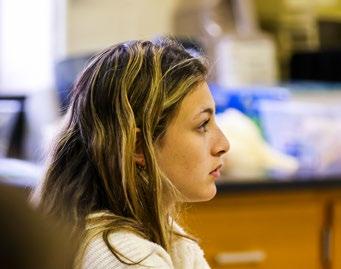

months. It takes GPS data from wearable devices, puts that into an algorithm, and analyzes it for player load,” he explained. “We can then go to coaches and say, ‘This person has been running a lot, and player load is high because of acceleration and change in direction. As a result, the person is more prone to injury and should rest a little more.’”
Such programs track fitness, fatigue, intensity, and stress scores over time depending on what information is inputted. David told students that wearable technology is a hot topic and growing career path in exercise science right now. “If you like sports, a great avenue for you to pursue in the future is sports analytics and player load,” he said.
He cited examples of groundbreaking work being done in the field—including sports drink companies building their own exercise science laboratories to determine the right beverage formulas for

specific types of training and athletic shoe manufacturers using in-ground force plates installed under various indoor tracks, courts, and fields to measure ground reaction force and design their shoes accordingly.
In addition, David is involved in a variety of projects to ensure the safety of student-athletes in schools around the country— tracking which ones have athletic trainers and ranking the effectiveness of those that do.
The Saints community is truly a family for David. His parents, Garth Martin ’78 and Nancy Mygatt ’78, are also graduates, as is his brother Robert ’05. And his grandmother, Gilda Martin, is a former Language Teacher who was awarded the Canterbury Medal in 2000.
David’s talk not only inspired Shane Cercone ’24 to incorporate more technology into his own training, it made him

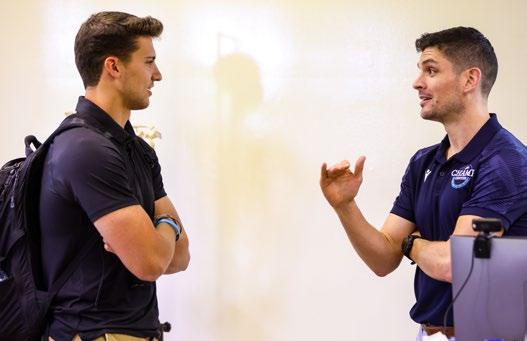
consider the idea of inspiring younger people himself one day.
“This made me realize more than ever how data and research can help us advance and perform our best,” Shane said. “I appreciate Mr. Martin coming back to share his work with our community. It is important to remember where you came from and, if you ever get to a position like he has, to be humble enough to help the younger kids.”
As class ended, David did just that—he offered to help his fellow Saints get a foot in the door for these exciting career paths. “My success came from networking, talking, and being personable with people, and those people gave me the opportunities to move forward,” he told them. “So, if you want to network, reach out to me. I will put you in touch with professionals who love to talk to students like you and help with whatever you want to do in the future.”

Wearables are becoming more and more common amongst amateur and professional athletes, but should student-athletes be using these technologies?
Dr. Laura Lewis is the Director of Science at the U.S. Anti-Doping Agency (USADA) and her early research was done on cycling and power meters—devices that measured how much power a cyclist could put out. Because of her interest in being able to accurately measure various aspects of fitness, she’s followed the development of wearables for monitoring athlete health and fitness with great interest.

But are any of these new wearables worth the money? What can they tell athletes about themselves? Is the data helpful or harmful to a young athlete? Here, we answer some of the most pressing questions caregivers and coaches are asking about wearables.
“I consider wearables to be any type of device that tracks information about your outputs,” says Lewis. “This can be a watch that measures heart rate or counts steps, a chest strap that monitors heart rate, a pod in your shoe that counts steps, a power meter on your bike—anything that’s giving you metrics about work you’re doing.”
If you wear any kind of smartwatch or fitness tracker, you’re using a wearable. There are more expensive models, including rings and watches and straps, that require subscriptions to access the data that they collect. There are patches and even subcutaneous devices that measure everything from sweat rate to hormone fluctuation to blood sugar levels. Essentially, if it tracks any aspect of health or fitness, it’s a wearable.
Wearables might seem like they’re everywhere, and indeed, since smartwatches became popular, they are worn by many people. However, Lewis points out that the technology behind wearables and their accompanying apps is still in its infancy. For example, sleep trackers are still using movement (and heart rate variability in some models), which is a far cry from the technology used in a sleep lab to measure sleep via brain waves.
“This is all so new,” says Lewis. “But the wearable companies tend to talk about their technology as though it’s been around forever. We’re still learning a lot and we’ve barely scraped the surface with what this technology is and what it can do. For example, heart rate variability is one of the big metrics that wearable companies measure, but we know that measuring it is very ‘noisy,’ meaning it’s not always accurate.”
Most commonly, wearables track basic metrics including step count. Often, wearables like smartwatches can track wrist-based heart rate, though depending on the device (and the size
of your wrist), these may or may not be very accurate. Many devices now track heart rate variability—essentially the timing between your heartbeats—in addition to heart rate. Many smartwatches and other wearables also track sleep and temperature. Some track motion to guess at the types of workouts you’ve done. Others estimate calories burned based on movement and heart rate. Some use GPS to track distance traveled, while others rely on the swing of your arm to simulate step count.
However, the data they collect isn’t always perfect. “When I look at power meters on the bike today, what I’m seeing is that they are typically not very well calibrated, and people aren’t getting reliable data,” says Lewis. The same is true of many wearables, especially the less-expensive ones, or the smartwatch-based wearables that add health tracking as an afterthought.
If athletes and their support team all have access to the data from a wearable, it can provide helpful information that can allow athletes to train smarter and catch early warning signs that they might be overdoing it. It may also provide valuable data about sleep habits and provide insight into what helps or hinders sleep. And if it senses temperature or heart rate variability, it may be able to let you know if you’re starting to get sick.
“Wearables can help us catch things like if an athlete is suddenly sleeping really poorly, or if they’re not recovering as well,” Lewis says. “You may already be feeling like something is off, but having the data to back up that feeling can be helpful. Activity tracking can also be helpful, especially if an athlete is on multiple teams or doing multiple sports, since it can provide coaches with a clearer picture of how much work their athletes are actually doing.”

ARE THERE ANY DOWNSIDES TO WEARABLES?
Knowledge is power, but caregivers and coaches do need to beware of creating an obsession. Unfortunately, an overload of data can contribute to issues like orthorexia, an unhealthy obsession with ‘healthy’ eating, and orthosomnia, an unhealthy obsession with getting perfect sleep. What starts out as a desire to get healthier can quickly become unhealthy.
“If you’re getting into bed and checking your phone so you can use the app that connects to your wearable before you go to sleep, that’s counter to what’s best for getting high-quality sleep,” Lewis points out. “It’s better to disconnect and stay disconnected, which also means not instantly checking the app in the morning to see how well it’s reporting you slept.”
Lewis also notes that we should never outsource how we’re feeling to a wearable: Make sure you’re also checking in with yourself regularly and doing your own assessment rather than relying on a device to tell you how well recovered you are in the morning.
Metrics also don’t exist in a vacuum. Even the most complicated wearable can’t read your thoughts or your emotions, and it can’t take every piece of data about you into account. It can only read certain metrics, which means it only is a small part of the whole equation when it comes to answering the question, ‘How are you?’
Especially for young athletes, this can be a negative because it takes away an opportunity to focus on how you feel physically and emotionally. Instead, you can look to the connected app on your phone to be told how you feel today—and that’s an uninformed way to live, says Lewis.
“These wearables should never replace keeping a training diary that you fill out personally,” she says. “So many elite athletes will talk about how they look back in their training diary to figure things out, and how helpful having that record is.”
Finally, wearables take time and consistency of use in order to provide usable data. That means you need to wear it for a few weeks before it can give you information that’s accurate for you. And you have to wear it consistently, Lewis points out. This isn’t easy when you also need to remember to keep your device charged, and in some cases, make sure that you’re wearing it positioned properly to get the most accurate reading possible.
Before you buy the wearable with the most fivestar reviews, ask yourself these questions and
look for a wearable that will best help you hit your goals:
Is it appropriate for your sport? There are some wearables—watches, straps and rings— that climbers and swimmers obviously won’t be able to wear during their sport, says Lewis. If you can’t use the wearable to collect data during training, the information it is able to glean outside of training will be significantly less useful.
What are you actually going to do with the data? If you’re a student-athlete, you likely have a fairly regimented practice and competition schedule, so if your wearable tells you that you need a rest day, will you be able to act on it? “Are you going to change anything based on what your watch said? Or are you going to override it based on what you feel or what you have to do?” Lewis asks. If it’s the latter, it may not be worth getting a wearable since you aren’t able to use it the way it’s intended.
Is it worth the money? Wearables can get expensive, especially when they have subscriptions attached, says Lewis. “Is it worth hundreds of dollars a year versus the free data you can get on your phone’s native health app?”
Is anyone else going to use this data? Some wearables and their accompanying apps make it easy to share information with coaches and/or parents. Lewis suggests thinking about if that’s desirable, and if the wearable you’re looking at allows you to do so.
Do you need the accountability of a wearable? If you’re a serious student-athlete, you likely don’t need the accountability that a wearable can provide when it comes to getting your steps in for the day, or sleeping as optimally as possible. But having the wearable can be a physical reminder to take your health seriously throughout the day, says Lewis. “It can serve as a reminder to check in with your health and fitness goals.”
It depends, says Lewis. If it’s in your budget, you have a clear plan on how to use it, and you know your athlete is not likely to get obsessed with the data, then a wearable can be informative and potentially optimize your training. However, if you don’t have a real reason for wanting one other than ‘my friends are all using them’ or ‘they look cool’ (two of the main reasons that researchers found teens opted for using a wearable), then it may not be worth the money.
Especially when it comes to wearables that require subscriptions, make sure you’re taking into account the recurring cost of the device. While many smartwatches and fitness trackers are a one-time purchase, the wearables that offer more in-depth analysis and more accurate technology tend to require subscriptions.
Do your homework and make your own list of pros and cons before making your purchase. Like most things, there are benefits and drawbacks to using a wearable, so you need to decide if it’s right for your athlete in their current phase of sport.
While wearables have surged in popularity, student-athletes do not necessarily need a wearable or fitness tracker in order to see performance benefits. Depending on the sport, a tracker or wearable may not be able to measure the metrics you’re looking for, and too much focus on certain metrics, like sleep or step count, can potentially lead to more anxiety versus an improvement in health outcomes.
TrueSport®, a movement powered by the experience and values of the U.S. Anti-Doping Agency, champions the positive values and life lessons learned through youth sport. TrueSport inspires athletes, coaches, parents, and administrators to change the culture of youth sport through active engagement and thoughtful curriculum based on cornerstone lessons of sportsmanship, characterbuilding, and clean and healthy performance, while also creating leaders across communities through sport.
For more expert-driven articles and materials, visit TrueSport’s comprehensive library of resources
This content was reproduced in partnership with TrueSport. Any content copied or reproduced without TrueSport and the U.S. Anti-Doping Agency’s express written permission would be in violation of our copyright, and subject to legal recourse. To learn more or request permission to reproduce content, click here.
